BSCI160 - Principles of Ecology and Evolution Unit 3 Diversity
1/254
There's no tags or description
Looks like no tags are added yet.
Name | Mastery | Learn | Test | Matching | Spaced |
|---|
No study sessions yet.
255 Terms
Analogous Traits
similar characteristics resulting from convergent evolution, therefore not derived from a common ancestor
similarities that are independently evolved
(same thing as convergent evolution)
Homologous Traits
Similar in structure, but does not have same function. They are inherited from a common ancestor.
-mammal bones are homologous
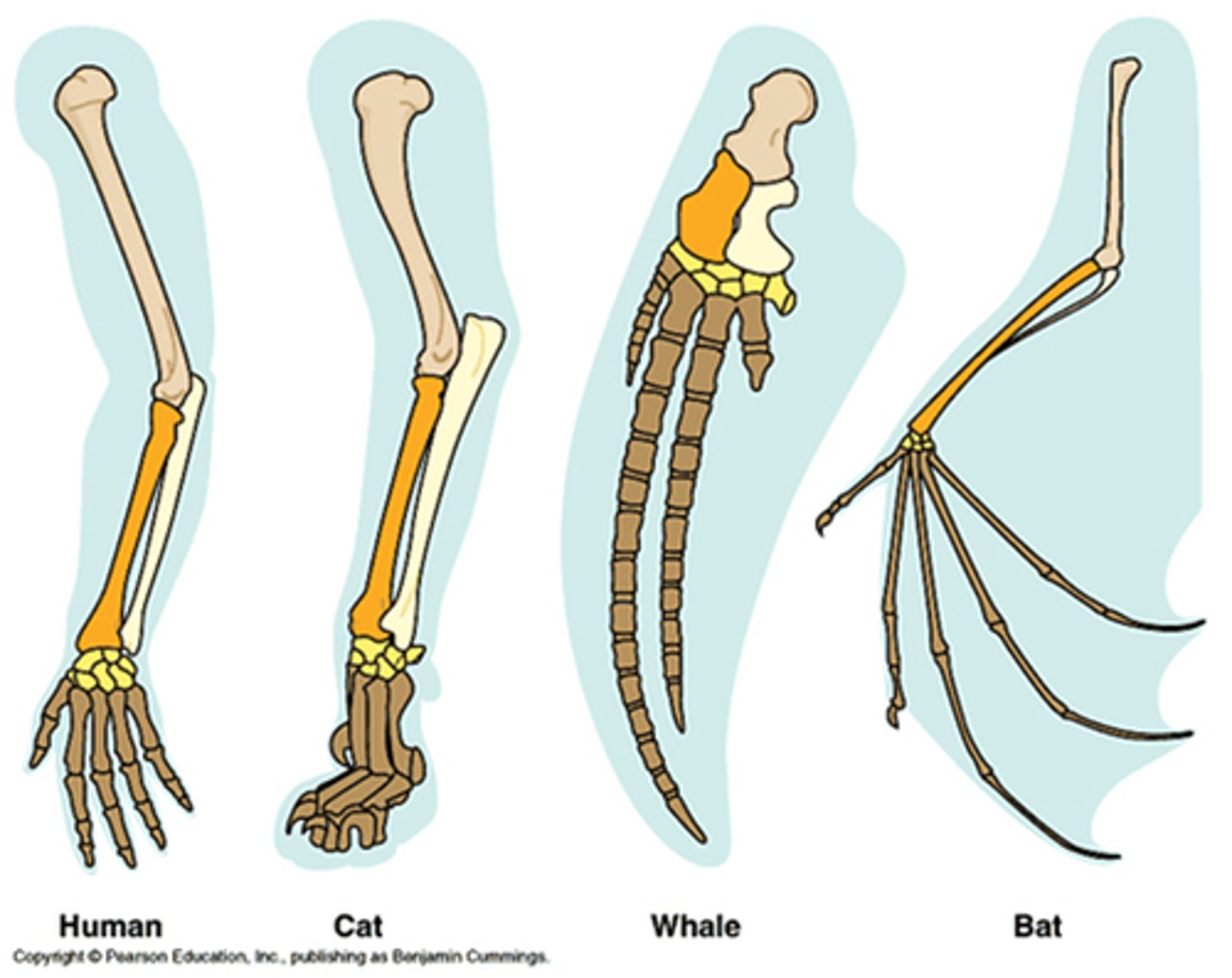
homologous vs analogous
homologous traits share a common evolutionary origin
analogous traits have a common function but not an evolutionary origin
phylogenetic analysis
-can compare molecular similarities of organisms
-need to construct
cladograms and phylogenies
Phylogeny
Evolutionary history of a species or group of species.
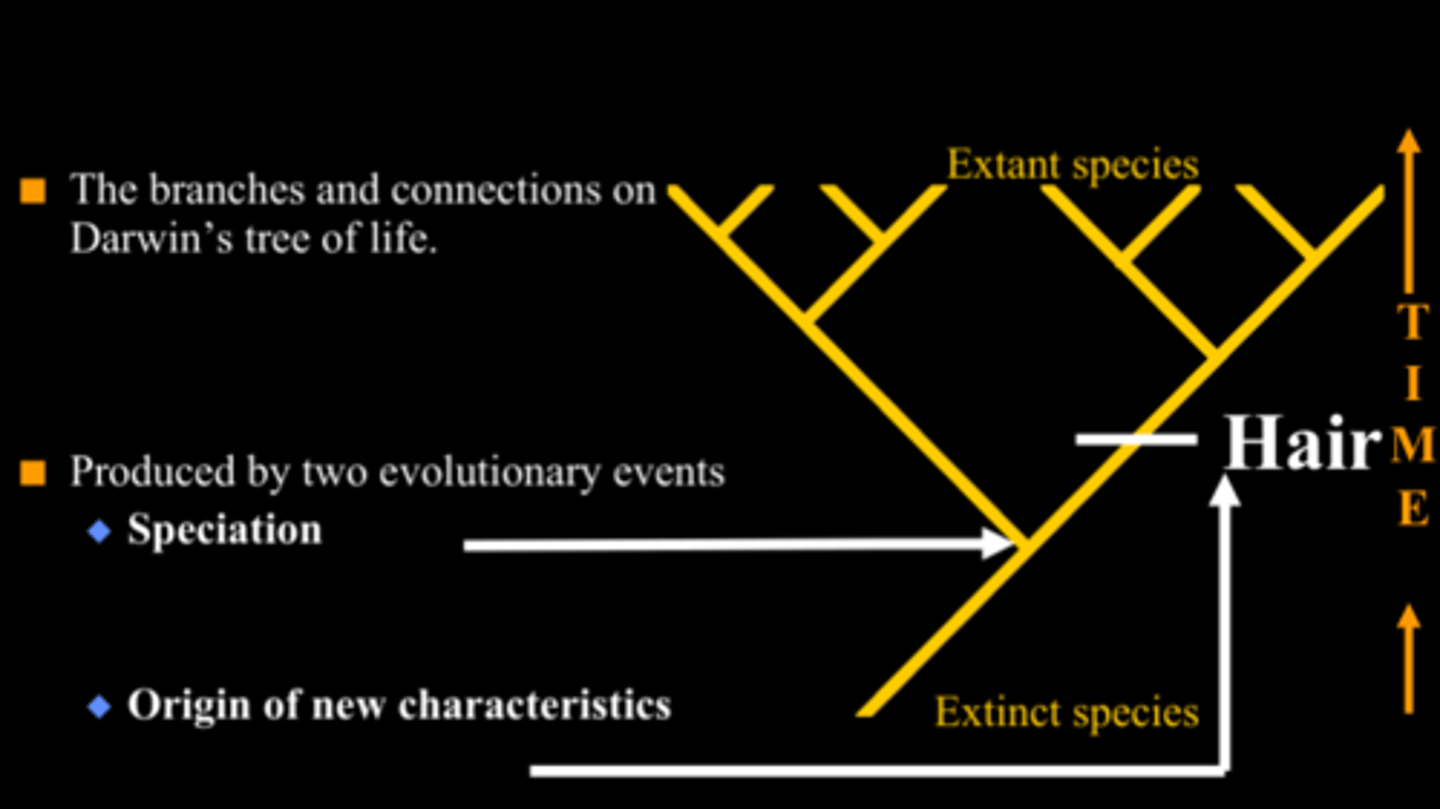
cladogram
a branching diagram depicting an estimate of the phylogeny
clade
A group of species that includes an ancestral species and all its descendants.

monophyletic
ALL descendants came from one common ancestor
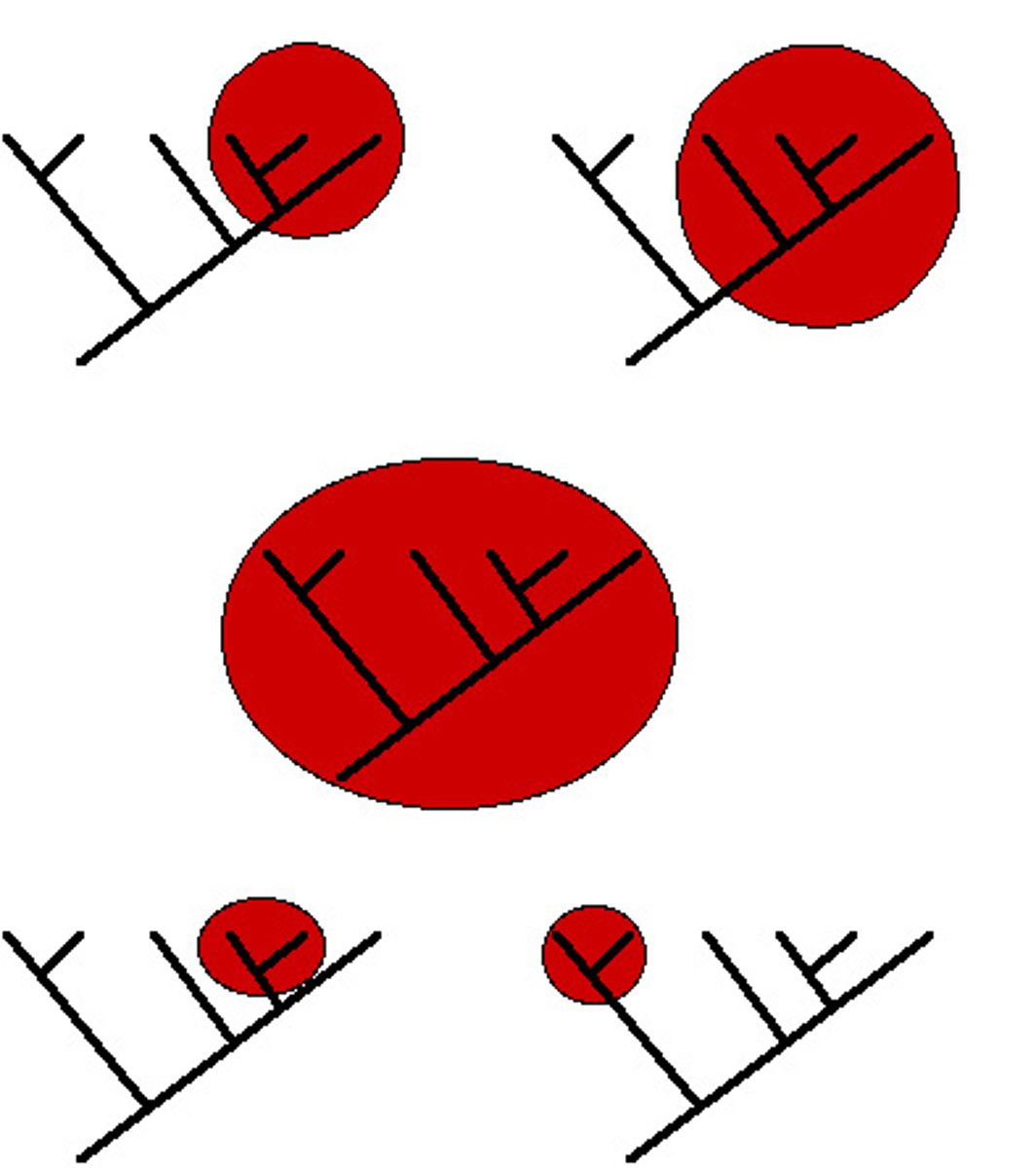
synapomorphy
-shared derived character
-single origin-an ancestoral species and all the descendent species grouped together
-implies close relationships
polyphyletic
pertaining to a group of taxa derived from two or more different ancestors
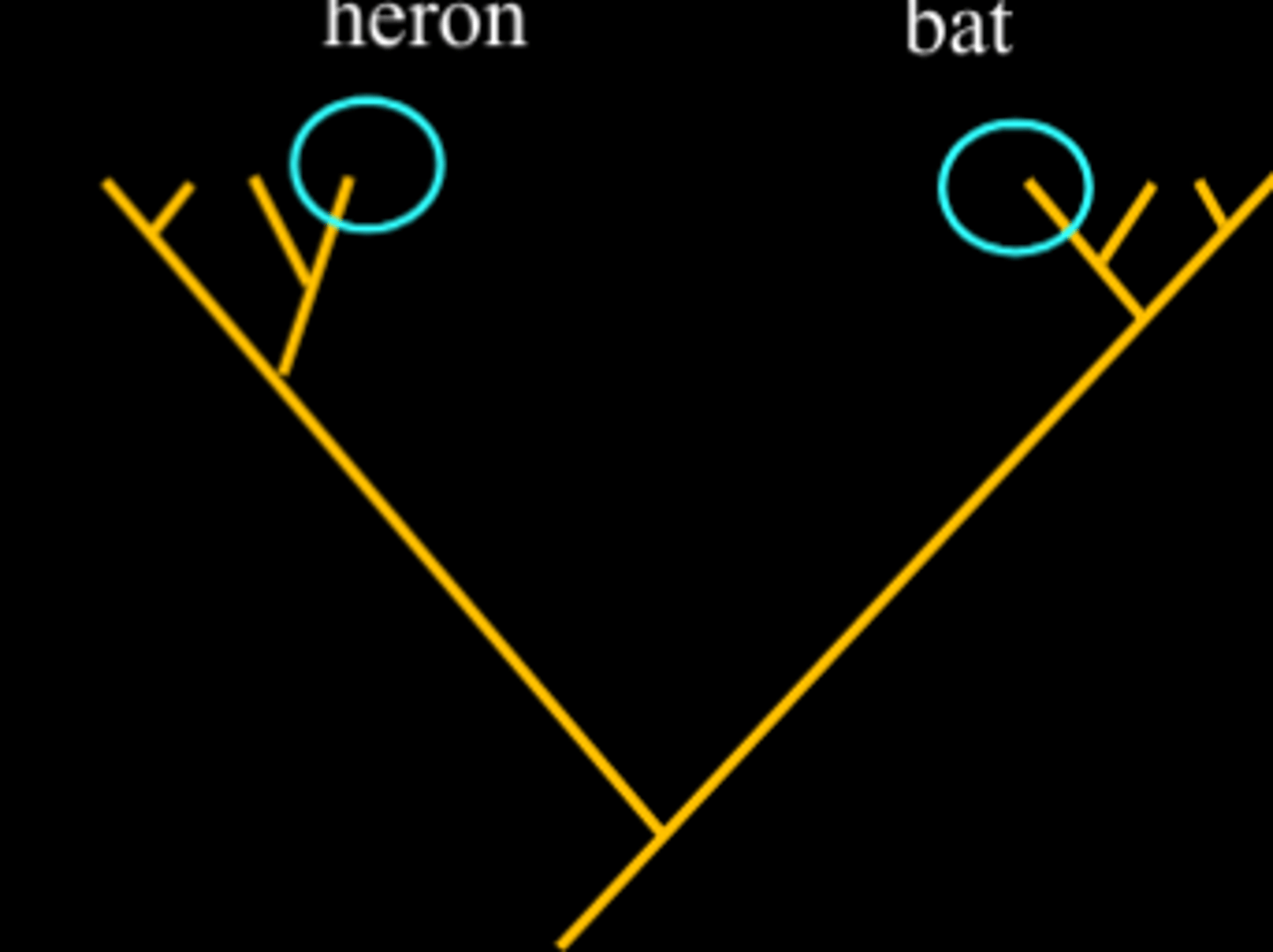
convergent similarity
-independent origins
-does not imply close relationship
-does not include common ancestor
paraphyletic
Pertaining to a group of taxa that consists of a common ancestor and some, but not all, of its descendants.
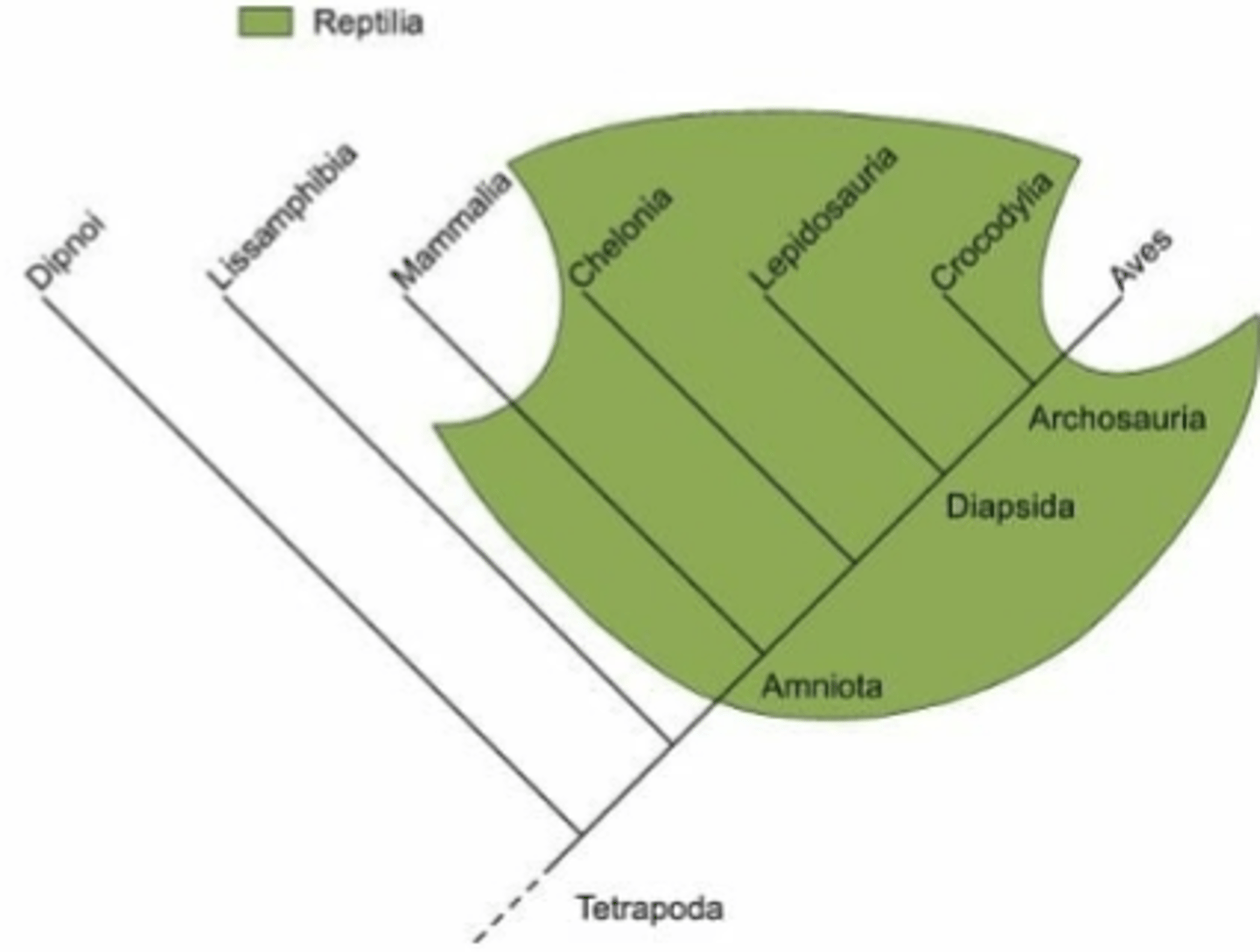
speciation
Formation of new species
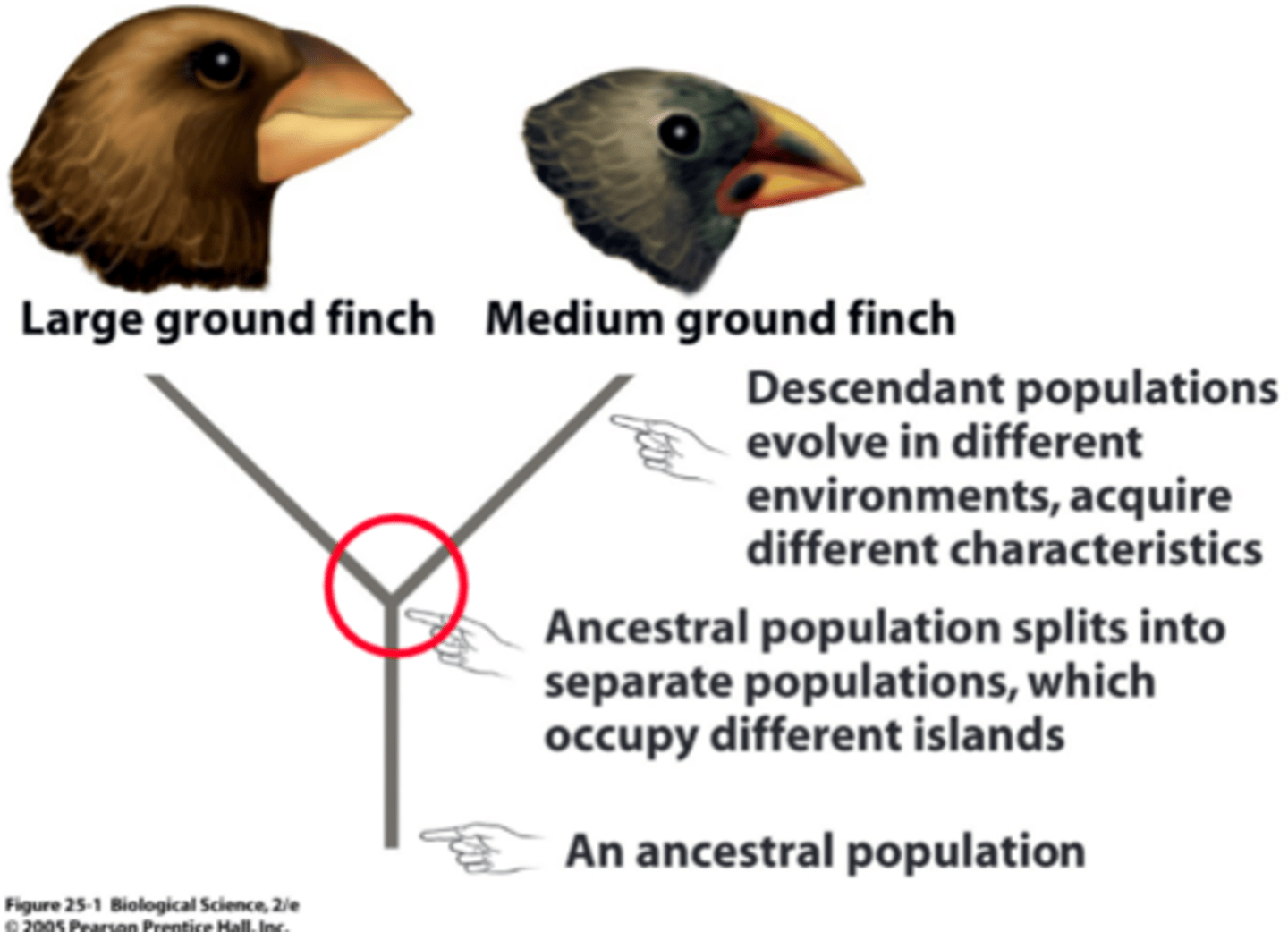
what is a species?
-no definition that applies to all cases
BIOLOGICAL SPECIES CONCEPT - BSC
-most widely used species concept
-all members have the potential to interbreed under natural conditions and produce viable, fertile, offspring
-some hybridization is normal as long as it doesn't occur naturally enough to overwhelm the boundary
LIMITATIONS TO THE DEFINITION:
-can be difficult to apply (not always clear who has the "potential" to interbreed
-does not apply to asexual organisms
-cant be applied to fossils
-how much hybridization is too much (the boundaries are arbitrary)
despite the limitations, the biological species concept is still generally useful for sexual species
-emphasizes reproductive isolation
other species definitions
1. morphological species concept is a practical substitute, looking at structure features
2. phylogenetic species concept - smallest group on a tree (lineage)
3. ecological - viewed in terms of niche
reproductive isolation
Separation of species or populations so that they cannot interbreed and produce fertile offspring
Prexygotic barriers
barriers that prevent the formation of a zygote/fertilized egg
postzygotic barriers
barriers that prevent the development of viable or fertile offspring
habitat isolation
a prezygotic barrier
may occupy the same range and potentially be able to hybridize, but prefer different habitats so they never (or rarely) mate
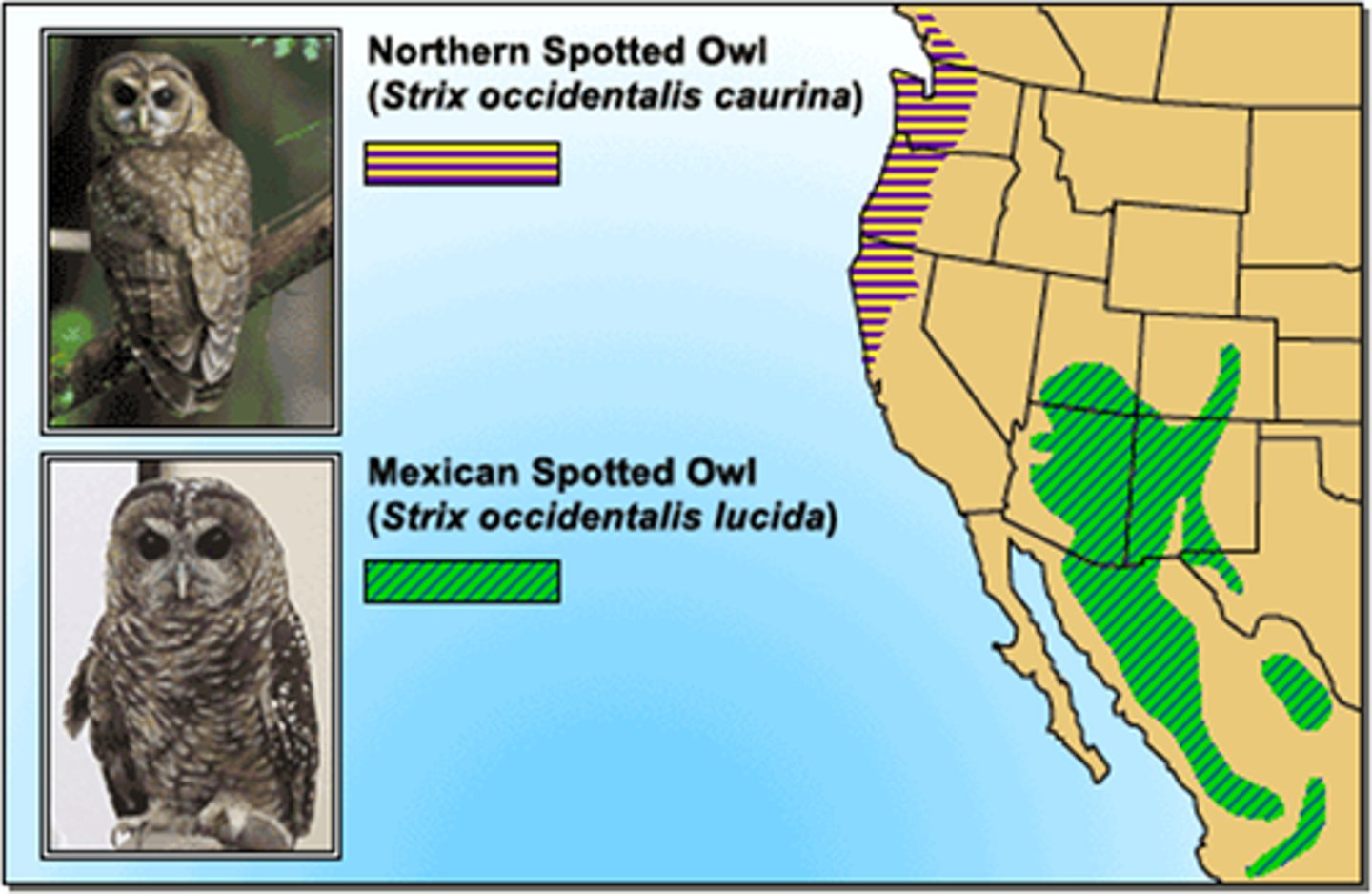
temporal isolation
prezygotic barrier
may potentially interbreed, but are "ready" at different times
many plants and animals breed at different times
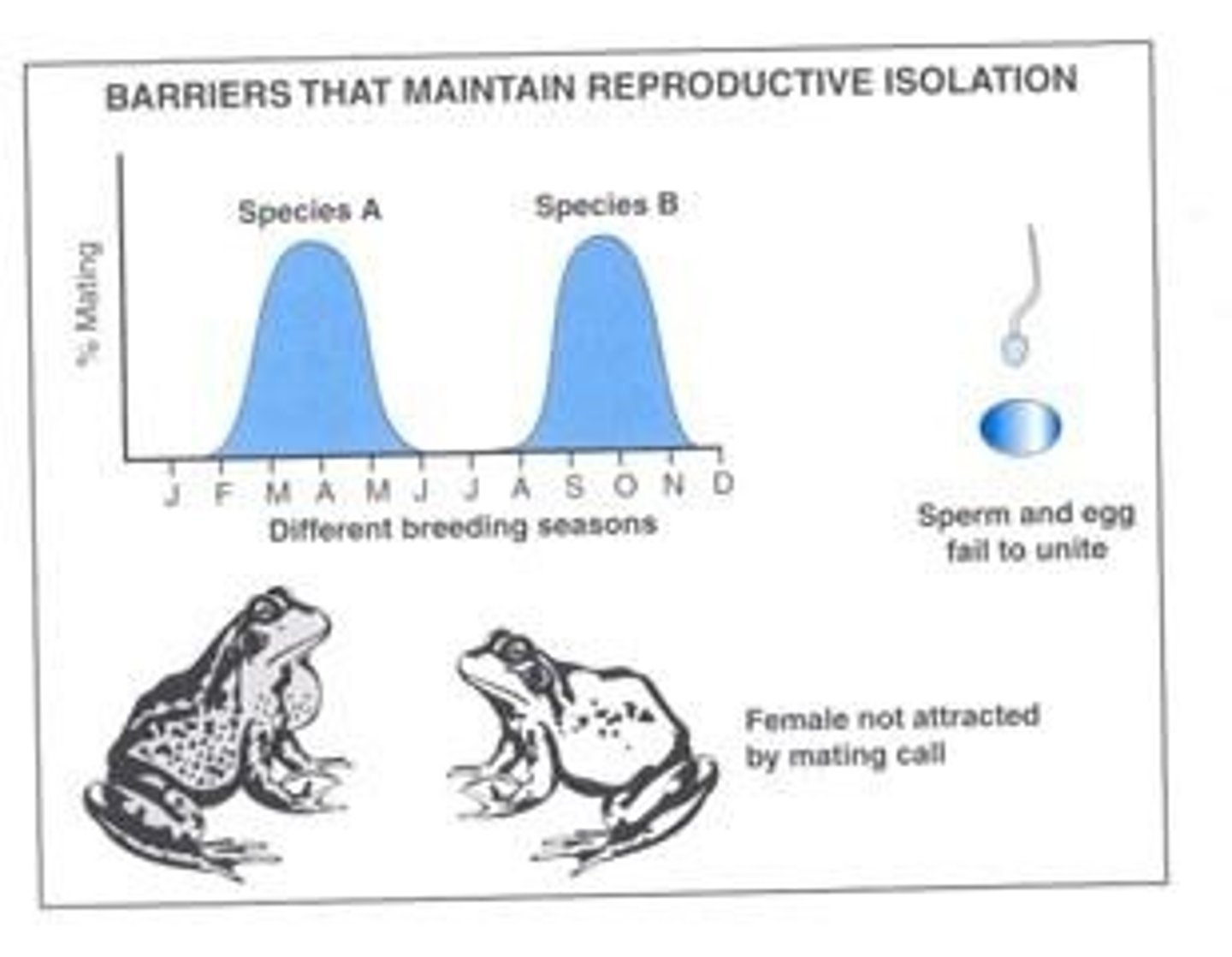
behavior isolation
prezygotic barrier
species may encounter each other but do not mate because of differences in courtship or other behavior
mechanical isolation
prezygotic barrier
differences in structure of sexual reproductive parts
species physically cannot mate
gametic isolation
prezygotic barrier
Sperm of one species may not be able to fertilize eggs of another species
gametes do not recognize each other due to different receptors
reduced hybrid viability
postzygotic barriers
-hybrid offspring do not develop
-hybrid offspring do not survive well
hybrid infertility
postzygotic barriers
hybrid offspring are sterile or have low fertility
ex. mules, tigons, etc
why?
odd number of chromosomes mean that gametes cannot be formed properly
hybrid breakdown
postzygotic barrier
Hybrid is fertile, but when they breed the next generation is sterile.
why?
allopatric speciation
The formation of new species in populations that are geographically isolated from one another.
how?
an ancestoral species grows and then a physical barrier takes place and separates the species and causes for different speciation
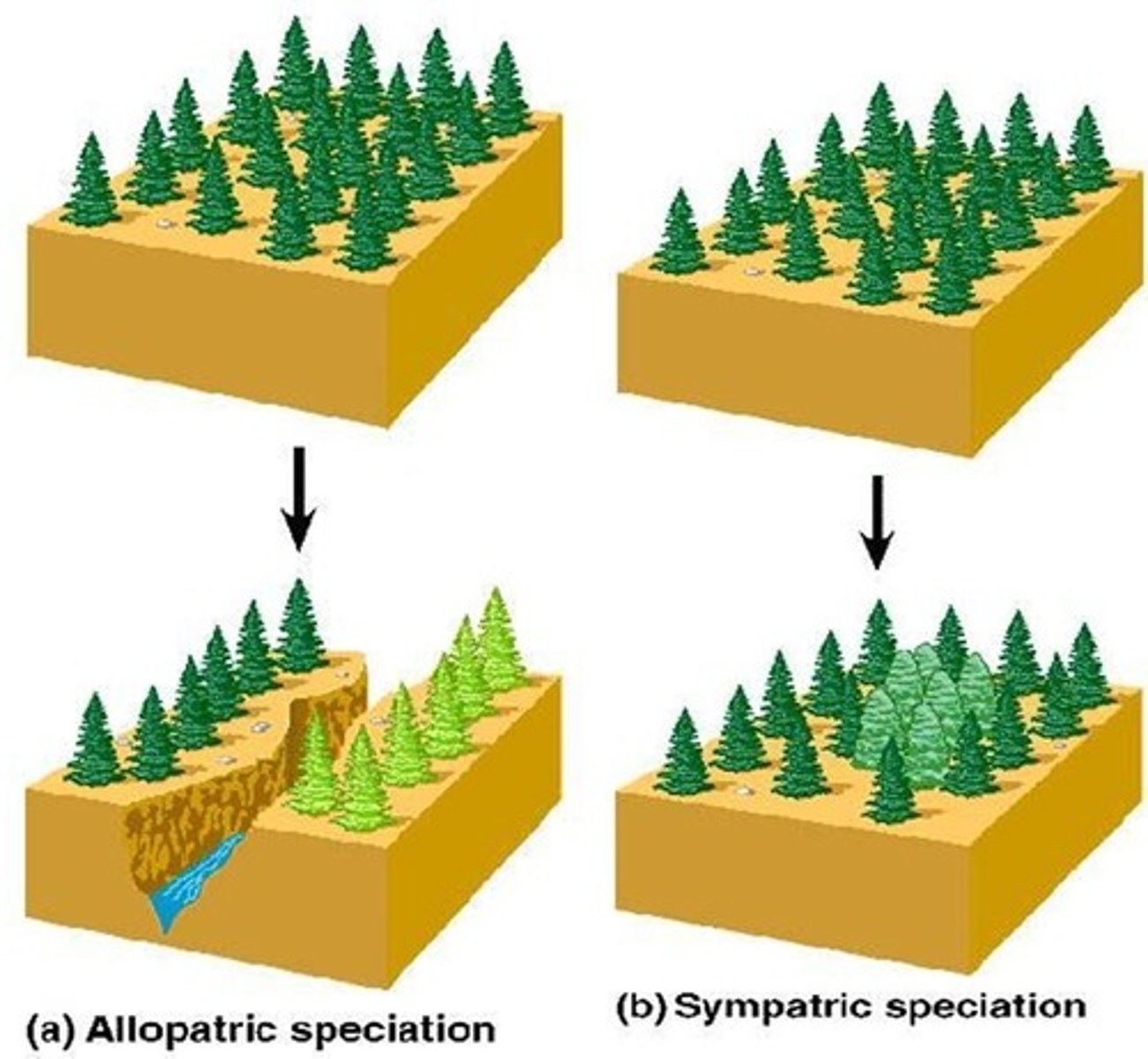
sympatric speciation
The formation of new species in populations that live in the same geographic area
how?
an ancestoral species grows and nondisjunction takes place, where a species has more chromosomes than necessary, making the species a completely new species in the same area

adaptive radiation
evolution of many diversely adapted species from a common ancestor
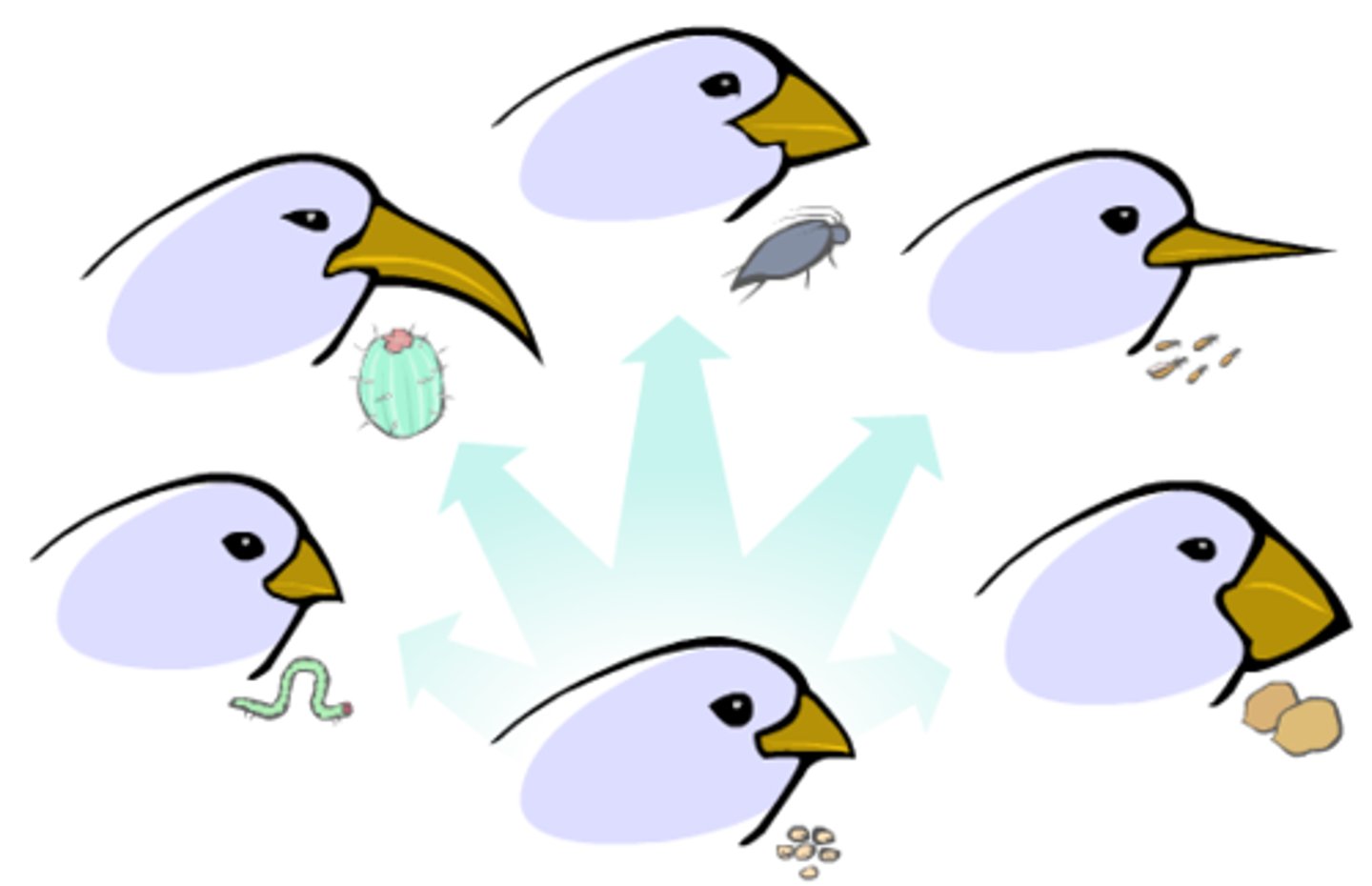
how do allopatric differences arise?
1. re-contact may reinfornce differences acquired in isolation
-reinforcement where the hybrid offered a low survival rate.....
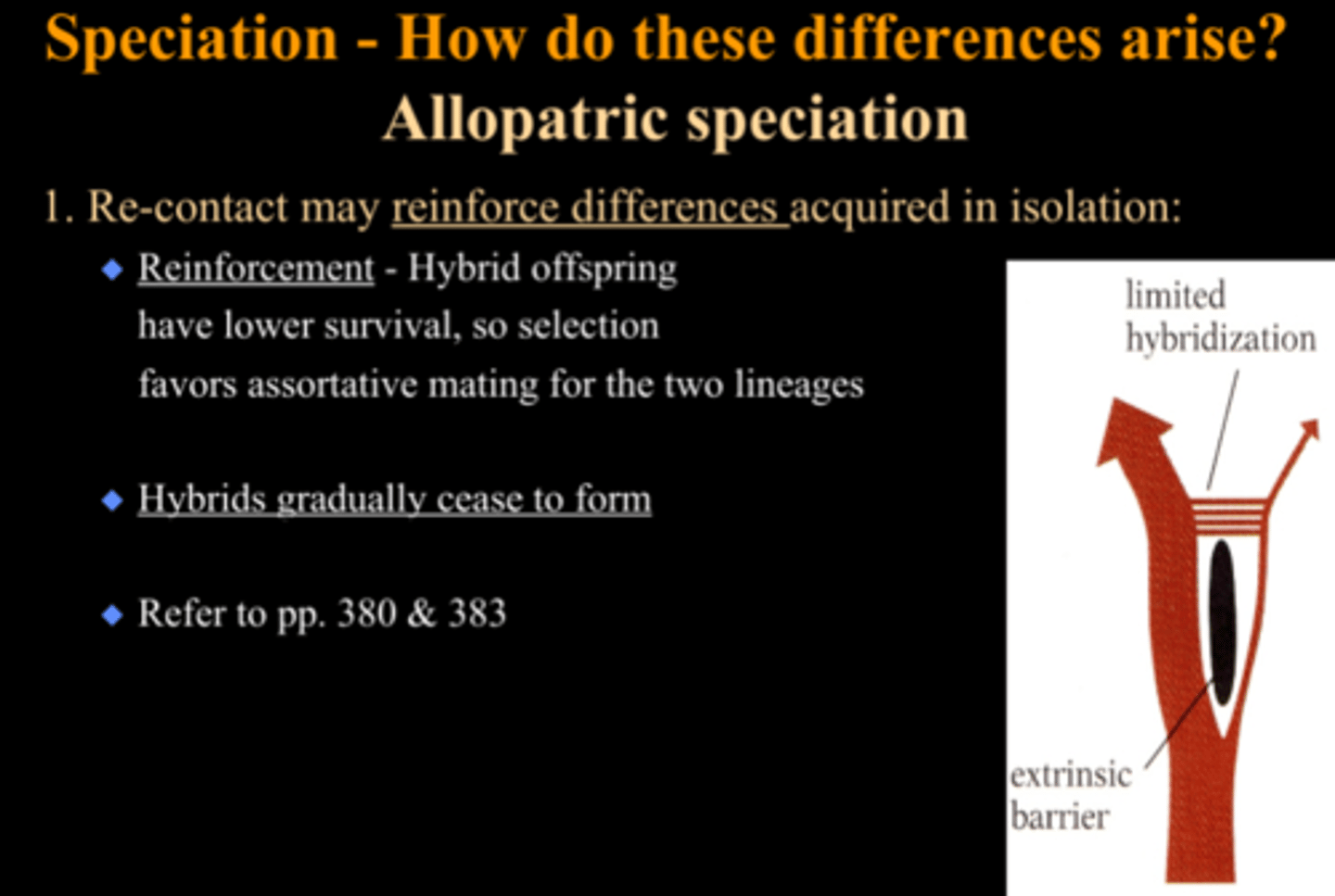
hybrid vigor
the characteristic of offspring that are stronger than their parents - produced through crossbreeding
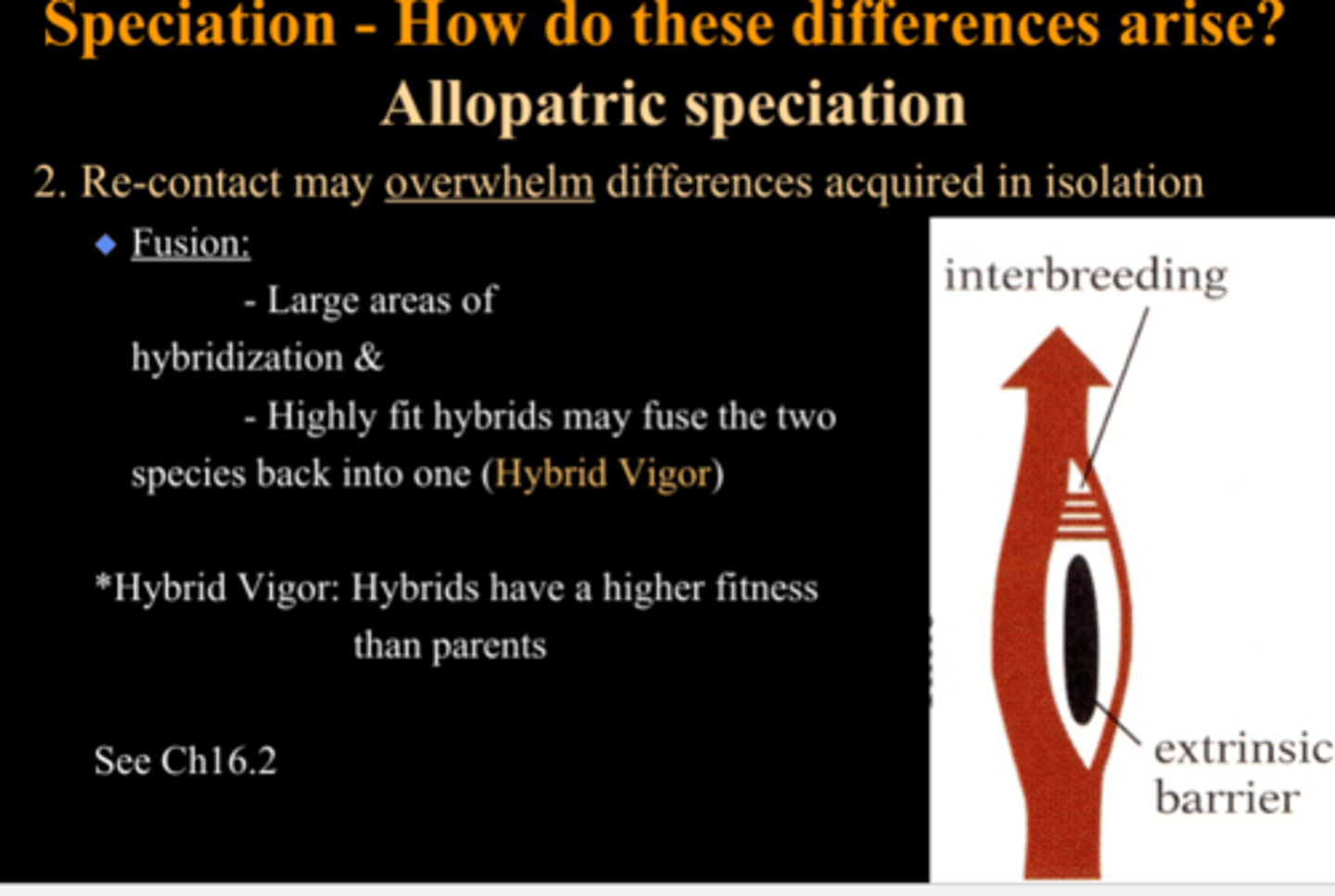
autopolyploidy
same species
-duplication of chromosomes number reproductively isolates offspring from parent population
-common in plants
-facilitated by ability to self fertilize
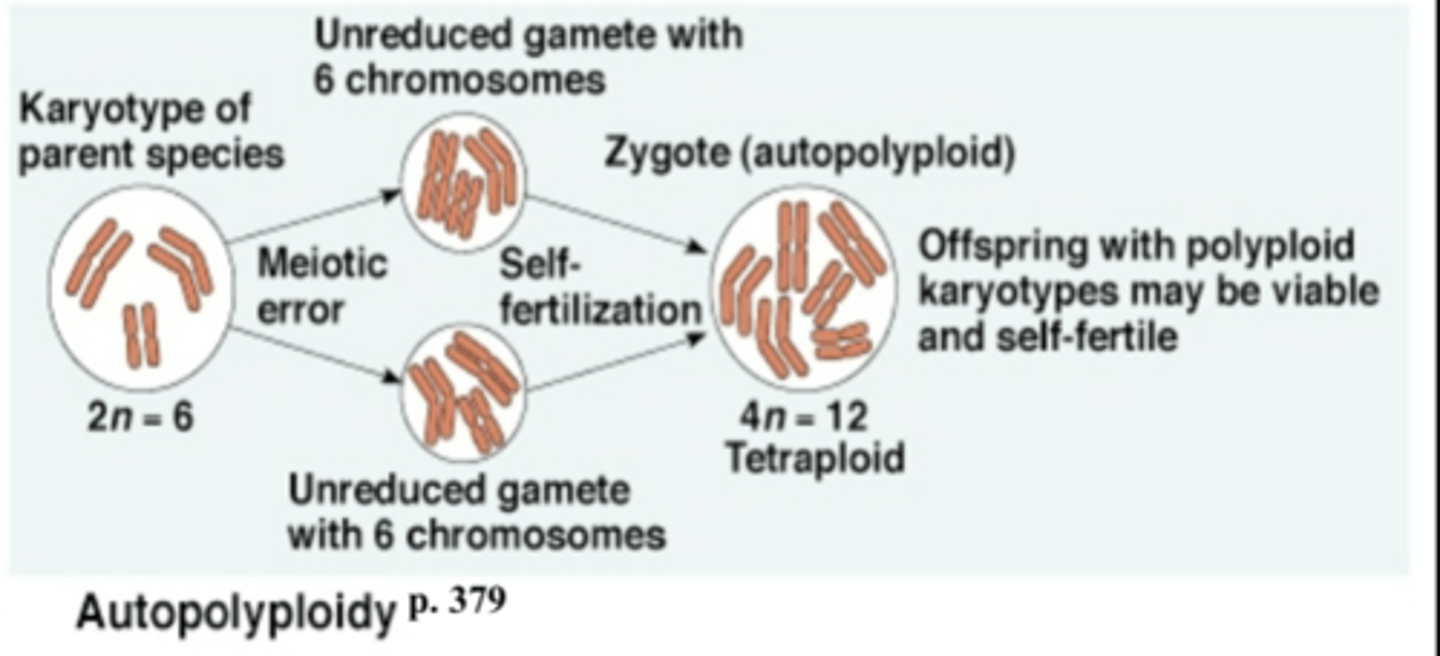
allopolypoidy
combining of chromosomes of two different species
-key force in plant speciation
-creates an intermediate niche

Which circumstance is most likely to lead to speciation in only a couple of generations?
A.reinforcement
B.polyploidy
C.gametic fusion
D.new environmental pressures
E.allopatric speciation
B. polyploidy
allopatric speciation takes a lot of time but polyploidy is sexual reproduction
polyploidy
A chromosomal alteration in which the organism possesses more than two complete chromosome sets.
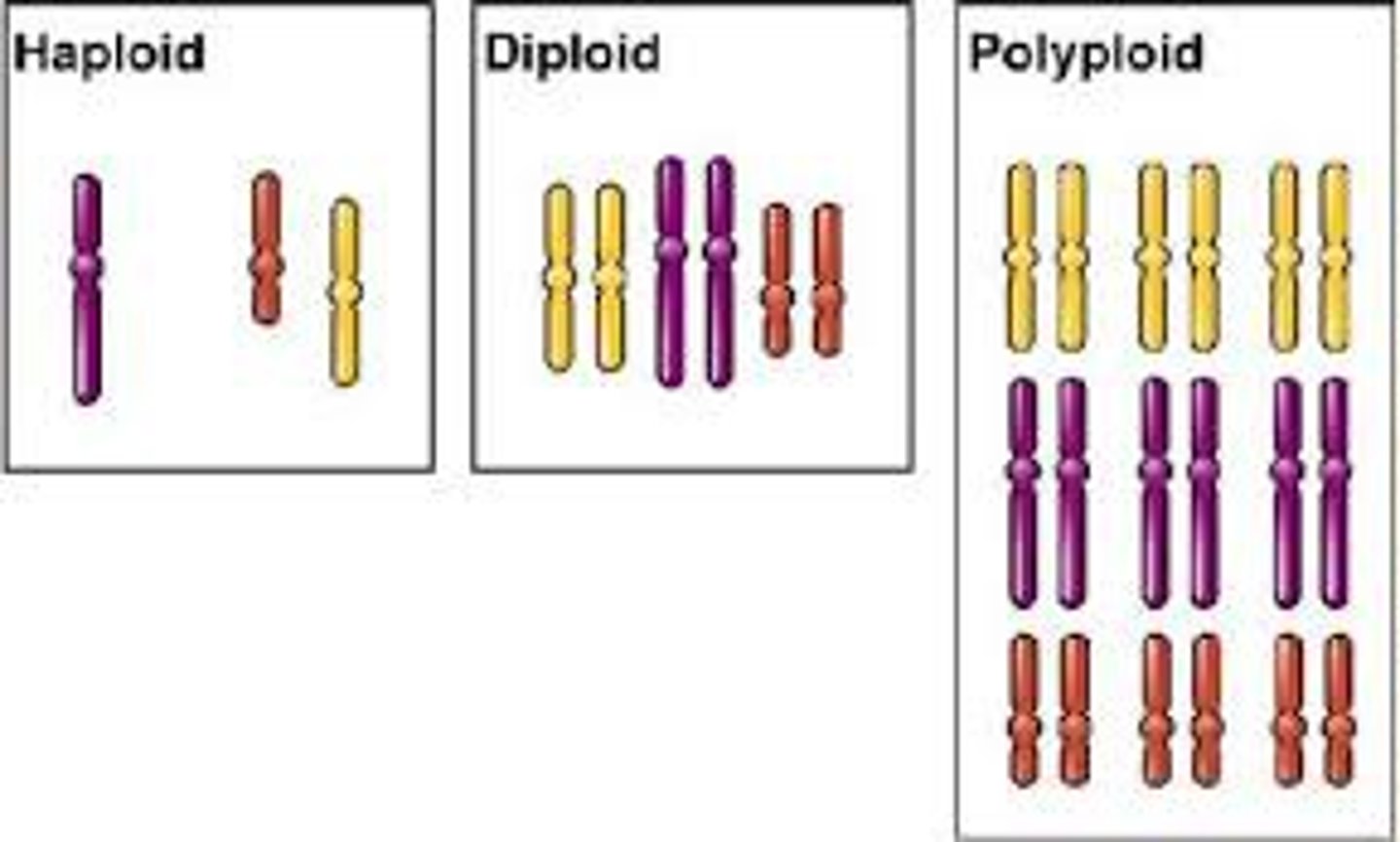
macroevolution
large-scale evolutionary changes that take place over long periods of time
broad patterns of evolutionary changes above the species level
Different macroevolution patterns
broad-scale patterns of change, diversification, and extinction in the fossil record
-patterns of change over time (gradualism) - anagenesis
-Patterns of diversification - cladogenesis
-crossing the bod boundaries - origin and consequences of new body plans = macroevolutionary patterns
gradualism (anagenesis)
the hypothesis that evolution proceeds chiefly by the accumulation of gradual changes
-classic darwinian view
-generally slow, constant change
-distinction among fossil species fairly arbitrary
-appear to sketchiness of fossil record to explain gaps
-does not claim that all change will be gradual, only that this is a predominant pattern
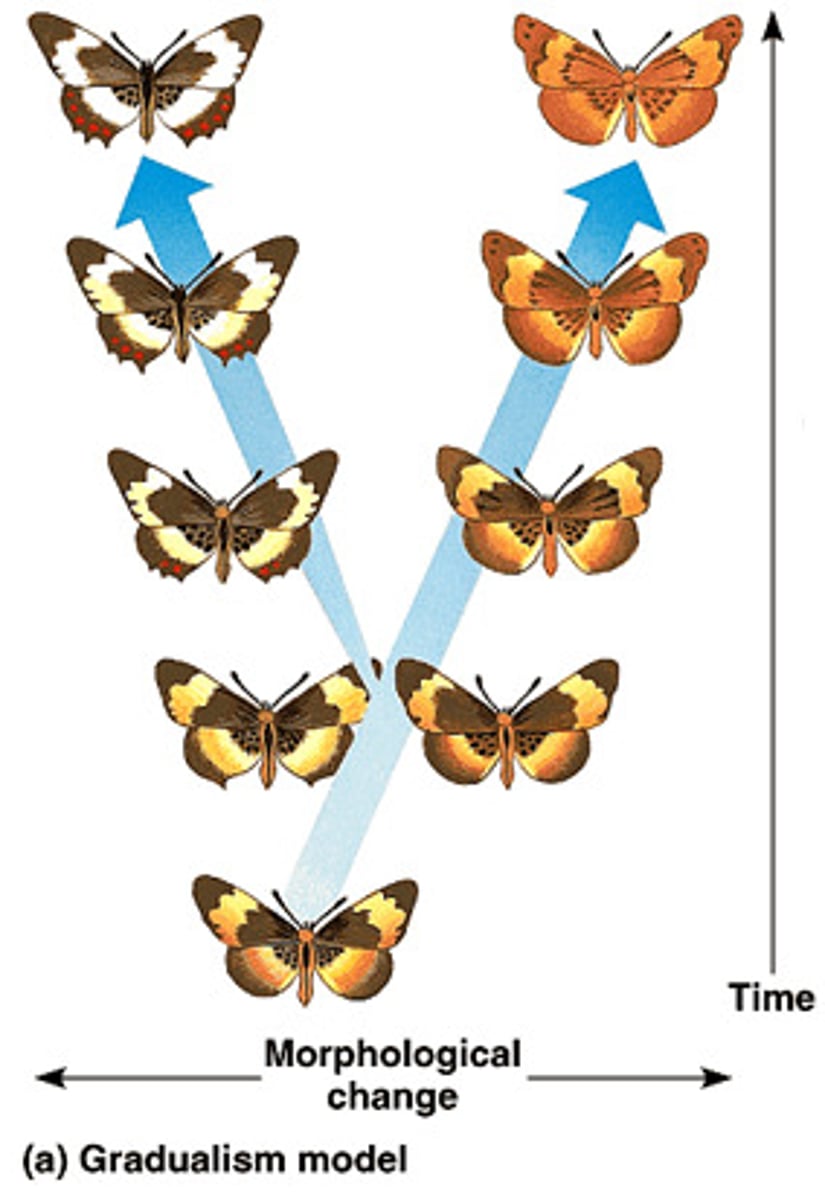
punctuated equilibrium (cladogenesis)
-emphasizes periods of stasis interspersed with periods of rapid change (geologically speaking)
-works well with cladistics
-emphasizes tat most change occurs at speciation
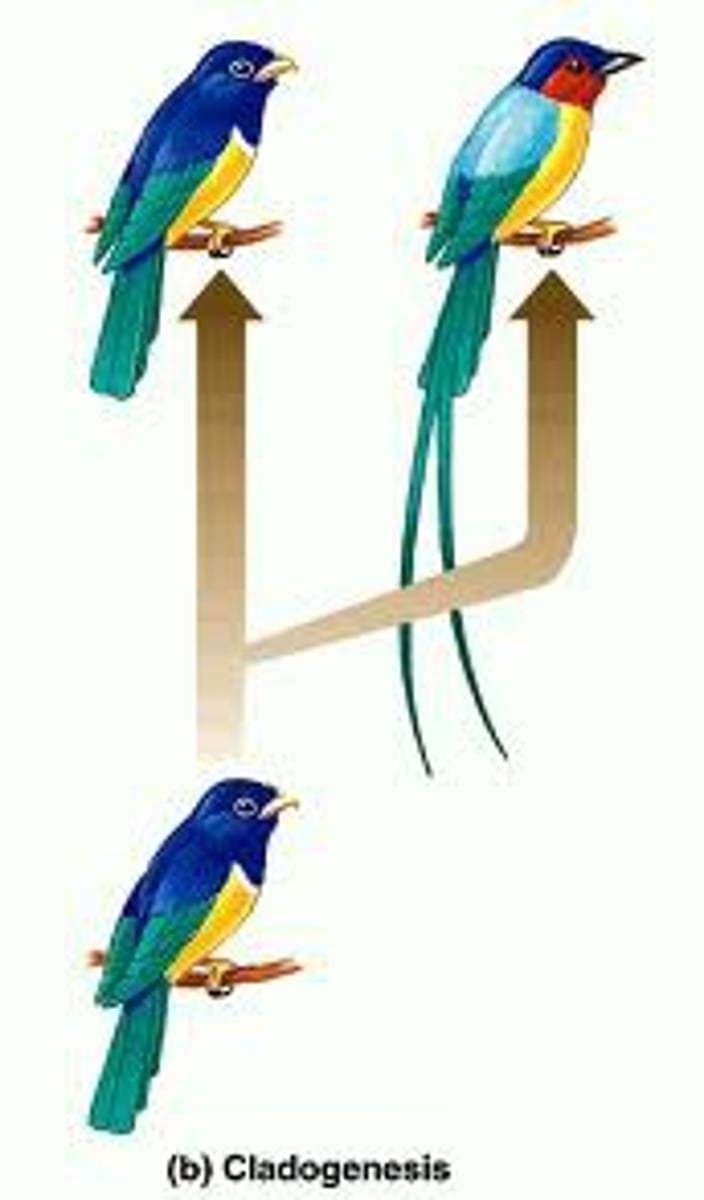
stasis
stopping
long periods of subtle evolutionary changes
sometimes called "living fossils" since the species has lived so long with such little change
cladistics
classification based on common ancestry
what causes stasis?
-stabilizing selection keeps species from changing
-variable directional selection that keeps the species fluctuating around a mean
-genetic/development constraints (retention of primitive features in the absence of appropriate variation or directional selection)
mosaic evolution
a pattern of evolution in which the rate of evolution in one functional system varies from that in other systems
in monotremes:
the evolutionary changes of different adaptive components of the phenotype of an organism at different times or at different rates in an evolutionary sequence
Species that have remained in stasis:
-horseshoe crab
-coelacanth
-gingko biloba
-amphioxus
"rapid" change
-origin of new species and characteristics over a time period that is short relative to the period of stasis
does NOT say that speciation/changes are instantaneous - merely that they happen too quickly to be generally captured in the fossil record
-depending on resolution of fossil record, may still be millions of years
What causes rapid diversification?
1. environmental change
2. ecological opportunity - entrinsic factors
3. ecological opportunity - intrisnic factors
environmental change
Natural or human alterations to the environment
example: cambrain explosion - brought high levels of oxygen into the atmosphere
cambrain explosion
earliest part of the Paleozoic era, when a huge diversity of animal species evolved
ADD MORE DETAIL FROM CANVAS
ecological opportunity - entrinsic factors
provides opportunities to occupy previously unavailable niches
adaptive radiation of mammals:
-pretty inconspicuous for 140 million years
-dinosaurs get wiped out
-many new ecological opportunties opened up for mammals
-"rapid" (20 million years) origin of most mammalian orders
-this was probably also a factor in the cambrian explosion of bilateria
ecological opportunity - intrisnic factors
key innovations - characteristics that open up new opportunities
DNA and genome based changes that allow for new features to evolve and new species to develop
monotremes
egg-laying mammals
-platypus
-echidna
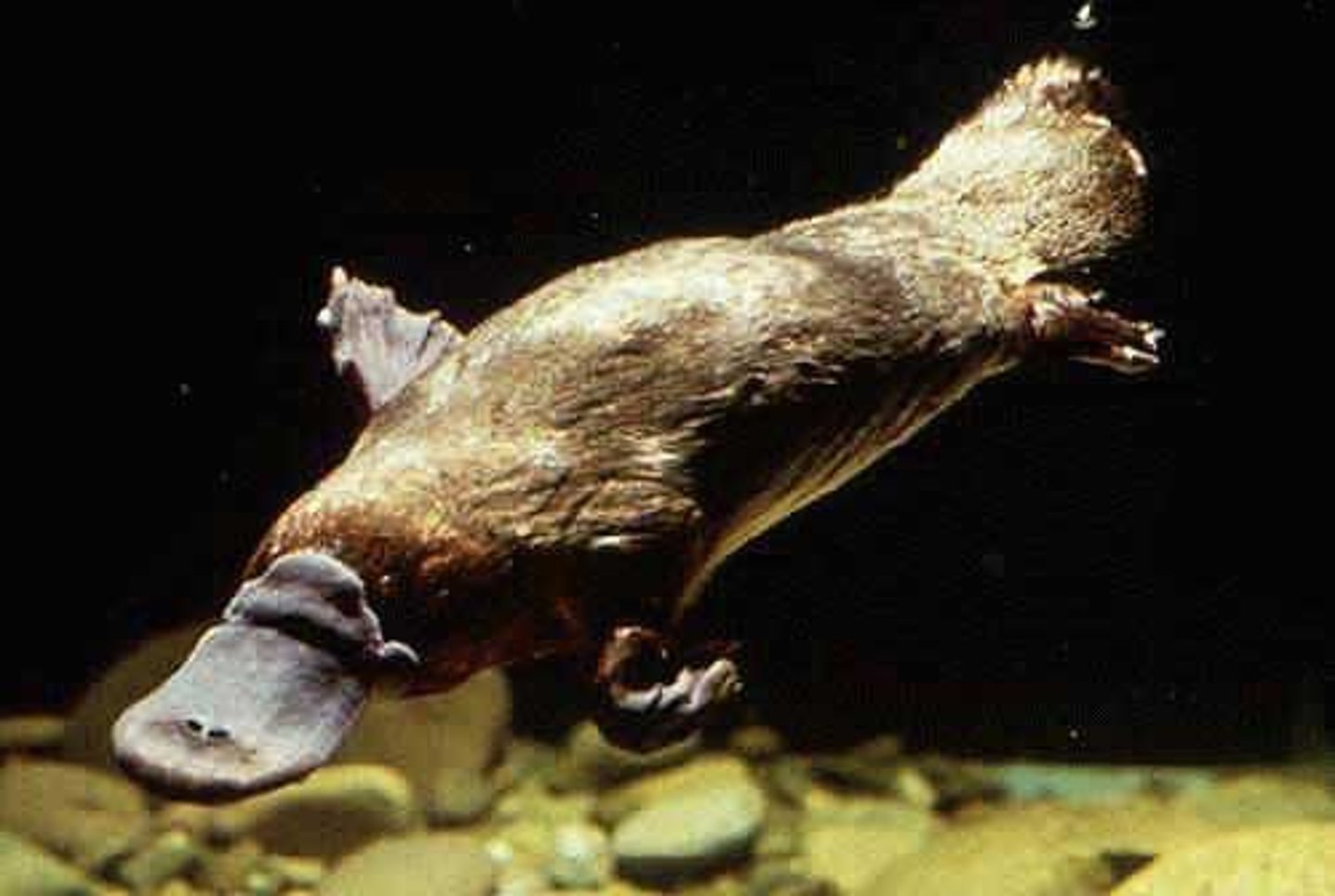
6 Origins of Evolutionary Novelty
1. Exaptation
2. Duplication
3. Serial Homology
4. Heterochrony
5. Lateral Gene Transfer
6. Homeotic genes and pattern formation
duplication
evolution of genes with novel functions
duplicated genes can evolve different (novel) functions
creates beneficial gene modification (such as the development of the hemoglobin gene that allows for better transport of oxygen)
serial homology
similarity between successively repeated parts in the same organism
ex. arthropodic limbs
-repetitive segments form into specialized form and structure
-duplicated limbs/segments can specialize
heterochrony
an evolutionary change in the rate or timing of developmental events
-changes in developmental timing can radically alter the adult appearance of an organism
genes "turn off" earlier in some organisms than they do in others (a giraffes "long neck" gene will stay on longer than a humans"
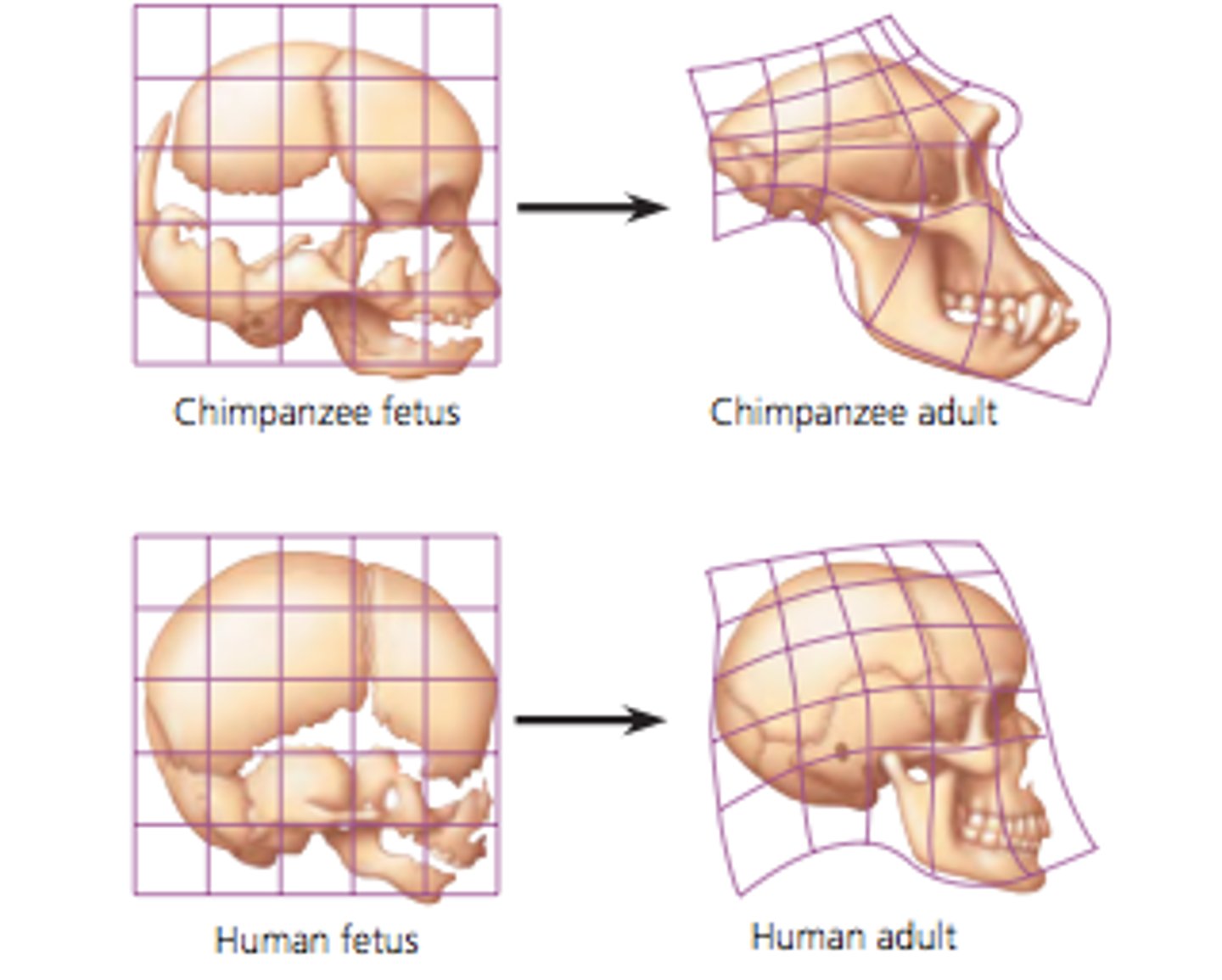
lateral gene transfer
transfer of DNA between two different species
-horizontal movement of individual genes, organelles or fragments of genomes from one lineage to another
-happens a lot with bacteria
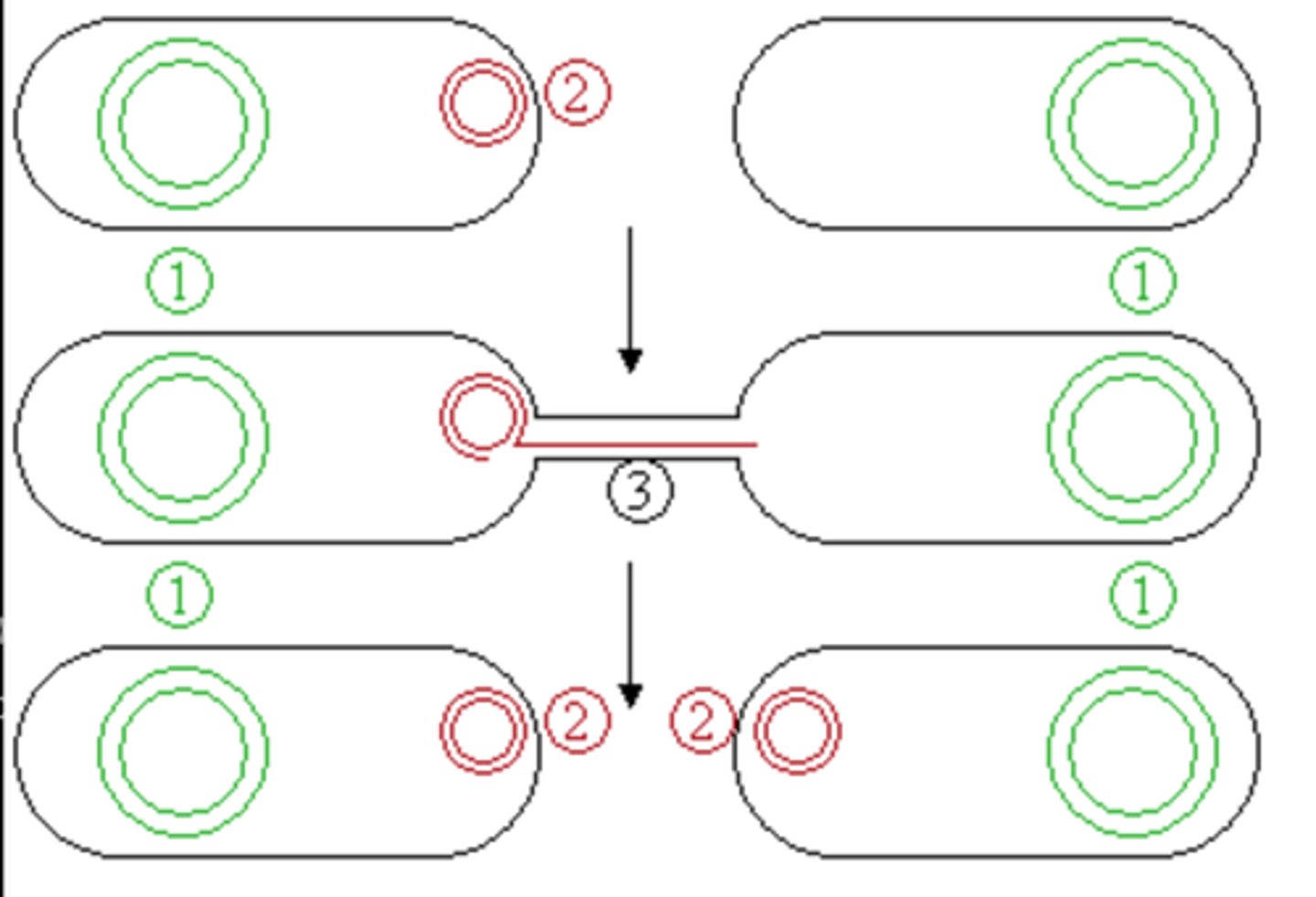
homeotic genes and pattern formation
simple developmental/genetic changes can have major effects
key genes in the development of individuals. a small change will have dramatic differences in the individual
Early history of life
earth formed 4.5 billion years ago
environment different with CO2, H2, and N2 in the atmosphere
-meteor impacts
-low oxygen levels
primordial/prebiotic soup - a title for referring to the conditions mentioned above.
life developed quickly with prokaryotes (through the process of glycolosis)
Changes in Earth's Physical Environment - Affected Evolution of Life
-atmospheric oxygen concentration initially had little to no free O2, until bacteria evoluved and photosynthesis as well (~2.5 billion years ago)
-O2 dissolved in water and reacted with iron to create iron oxide, which accumulated in alternating layers in rock (seen as banded iron formations)
-these formations are evidence of the earliest photosynthesis
-O2 began to accumulate into the atmosphere
-cyanobacteria formed stromatolines (abundant in fossil record and are still formed today in salty waters)
-O2 released by cyanobacteria allowed evolution of oxidation reactions as an energy source for ATP synthesis
stromatolines
layering in rocks that was formed from cyanobacteria presence
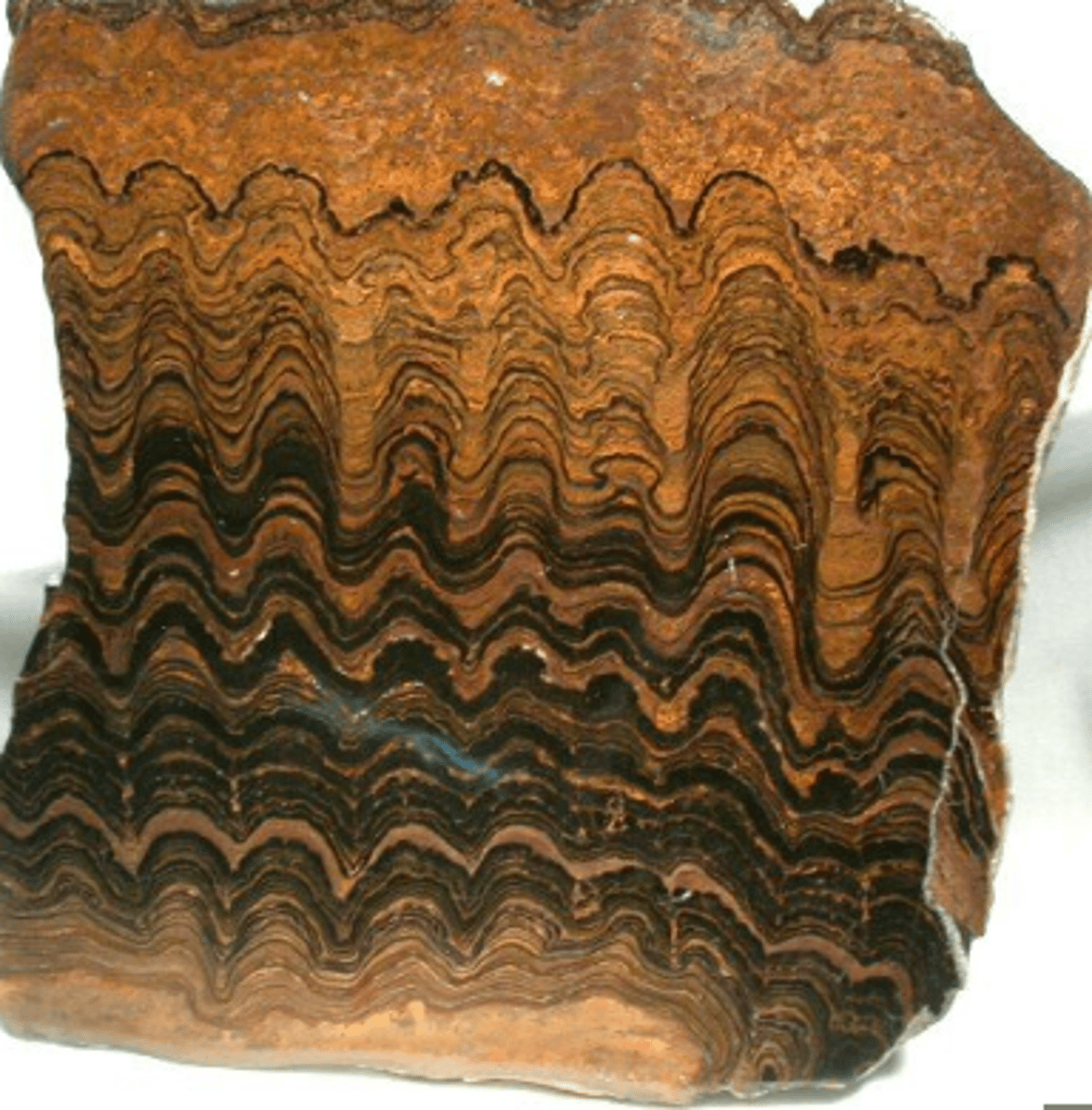
earth's history in a calendar year:
Between March-October, prokaryotes ruled and changed earth
-LIFE EMERGED IN MARCH with the 1st bacteria
-Before october - only single celled organisms existed
-start of october - eukaryotes (multicellular organisms) developed
-November - plants invaded the land and most major animal groups appeared in oceans
-early december - flowers and mammals evolved
- december 26th - dinosaurs ruled the environment until the asteroids hit wiping out all but birds
december 31st, 30 min before midnight - humans came into existence
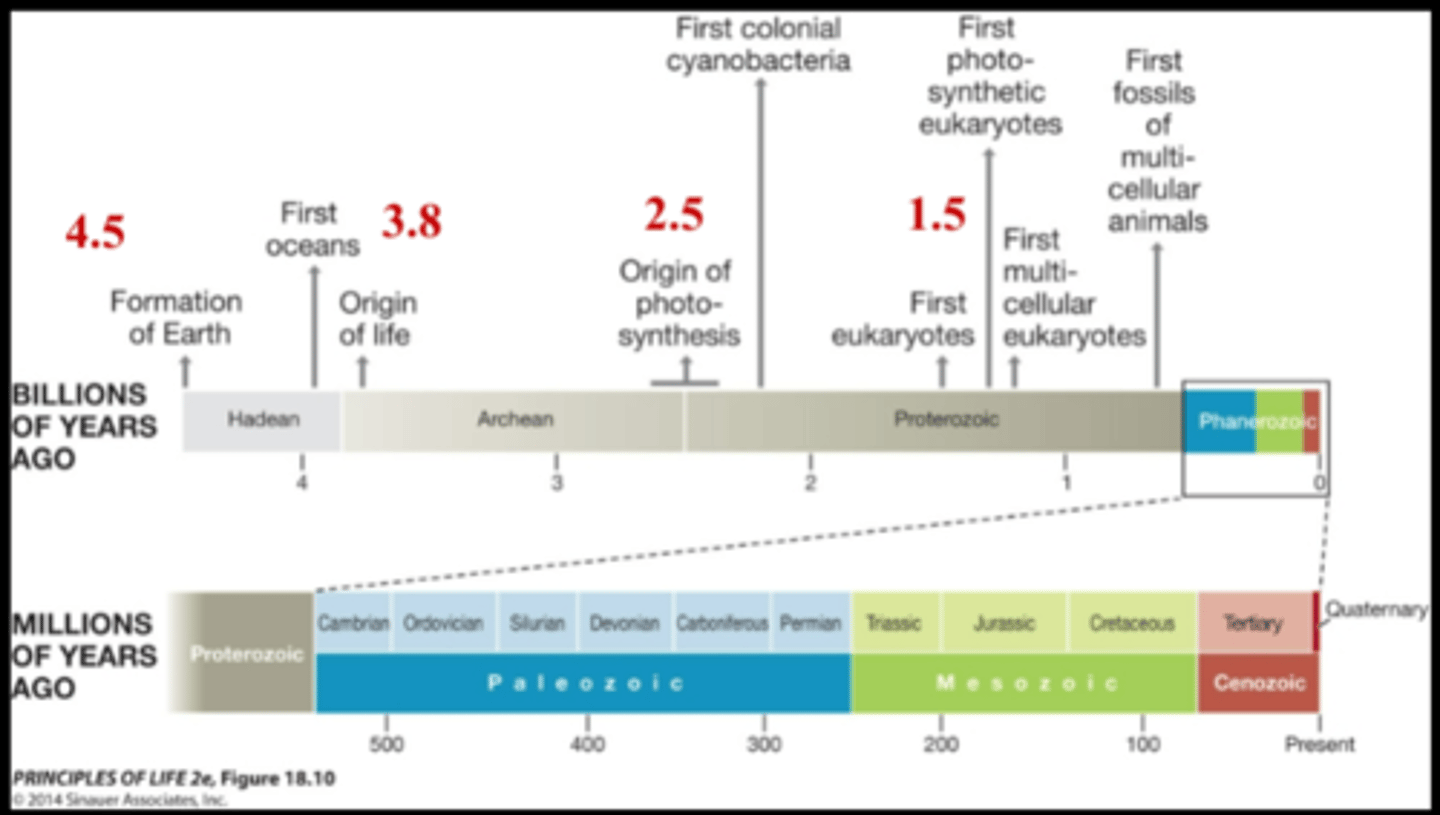
Prokaryotes
Cells that do not contain nuclei
-bacteria
-archarea
a PARAPHYLETIC group
dominant life forms on earth
-10x the biomass of all eukaryotes
-extreme metabolic diversity
-the basis for all eukaryotic metabolism
prokaryotic diversity
high metabolic diversity, low structural diversity
eukaryote diversity
low metabolic diversity, high structural diversity
sister taxa to the eukaryotes
Prokaryotes vs. eukaryotes
PROKARYOTES ("pro" = before, "karyon" = nucleus)
1. Unicellular
2. no nuclear envelop around genetic material
3. no membrane bound organelles (only have ribosomes)
4. circular DNA, with relatively few genes in plasmids
5. no mitrosis/beiosis; instead binary fission
EUKARYOTES ("eu" = true, "karyon" = nucleus)
1. Unicellular or Multicellular: protists, fungi,
plants & animals
2. Nucleus; consist of mutiple chromosomes
3. Bigger
4. Cell wall ONLY in fungi & plants
5. Ribosomes (40 & 60S)
6. Membrane-bound organelles
7. Transcription in nucleus; Translation in cytosol
BOTH
1. Cytoplasm
2. DNA
3. Cell membrane
4. ribosomes
5. Activities of living things

Gram-positive bacteria
-simple cell wall
-thick peptidoglycan layer
-contains cytoplasmic membrane
Positive stains NOT pink (stains purple/blue)
gram-negative bacteria
-complex cell wall
-outermembranse
-thin peptidoglycan layer
-inner membrane
ex. cyanobacteria
stains pink due to the thin layer of peptidoglycan
Evolutionary clock
prokaryotes (bacteria and archaea) developed 3.8 billion years ago
cyanobacteria developed 2.8 billion years ago
Oxygen concentrations over time
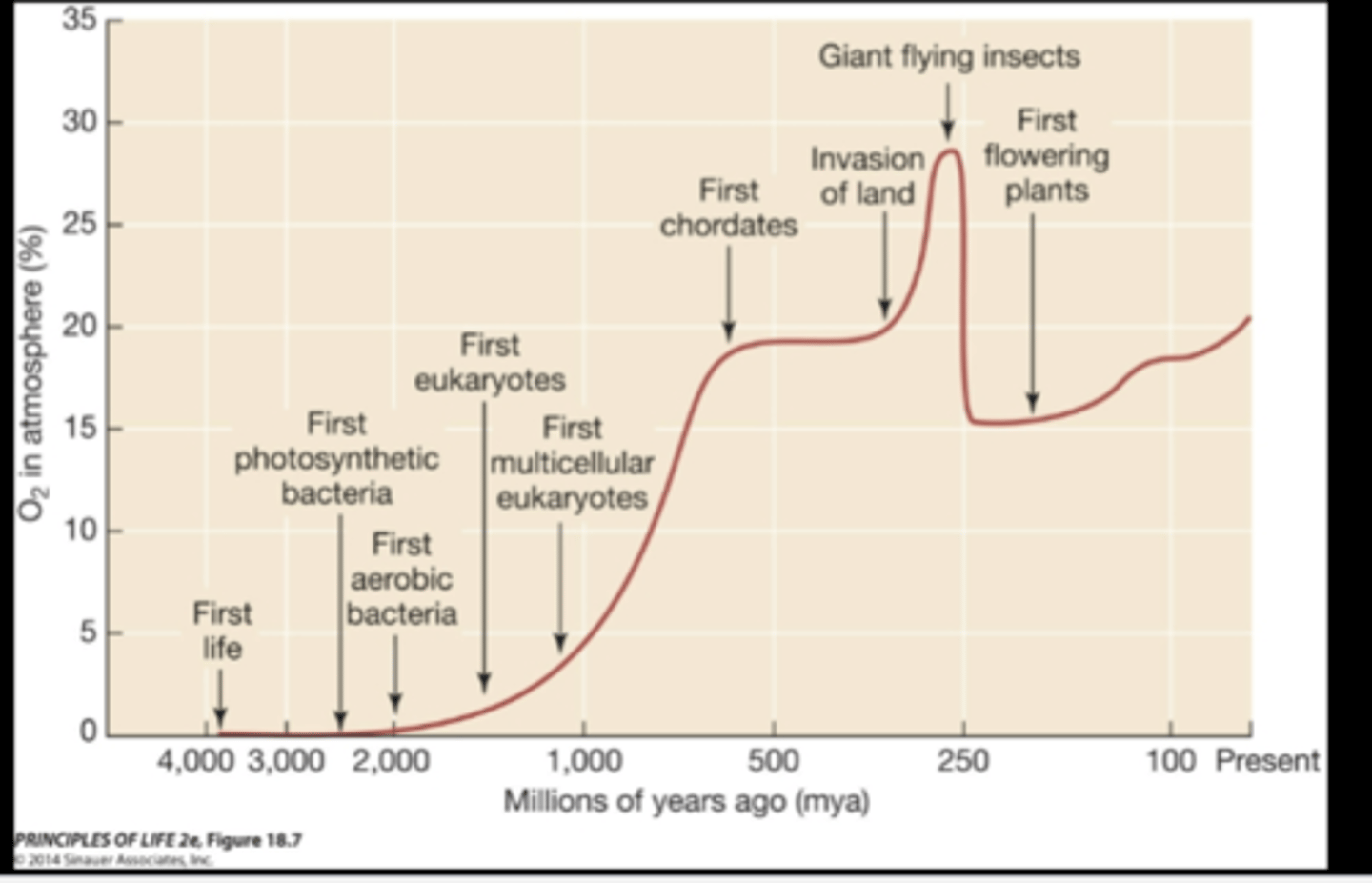
Swapping genes - lateral gene transfer (LGT)
prokaryotes can horizontally transfer genes (crucial for evolution)
processes:
-transduction
-transformation
-conjugation
transduction
transfer of genes via viral infection (from a bacteriophage)
a bacteriophage will infect a different bacteria, pick up genetic material, and then travel to a different bacteria and leave the genetic material within the bacteria
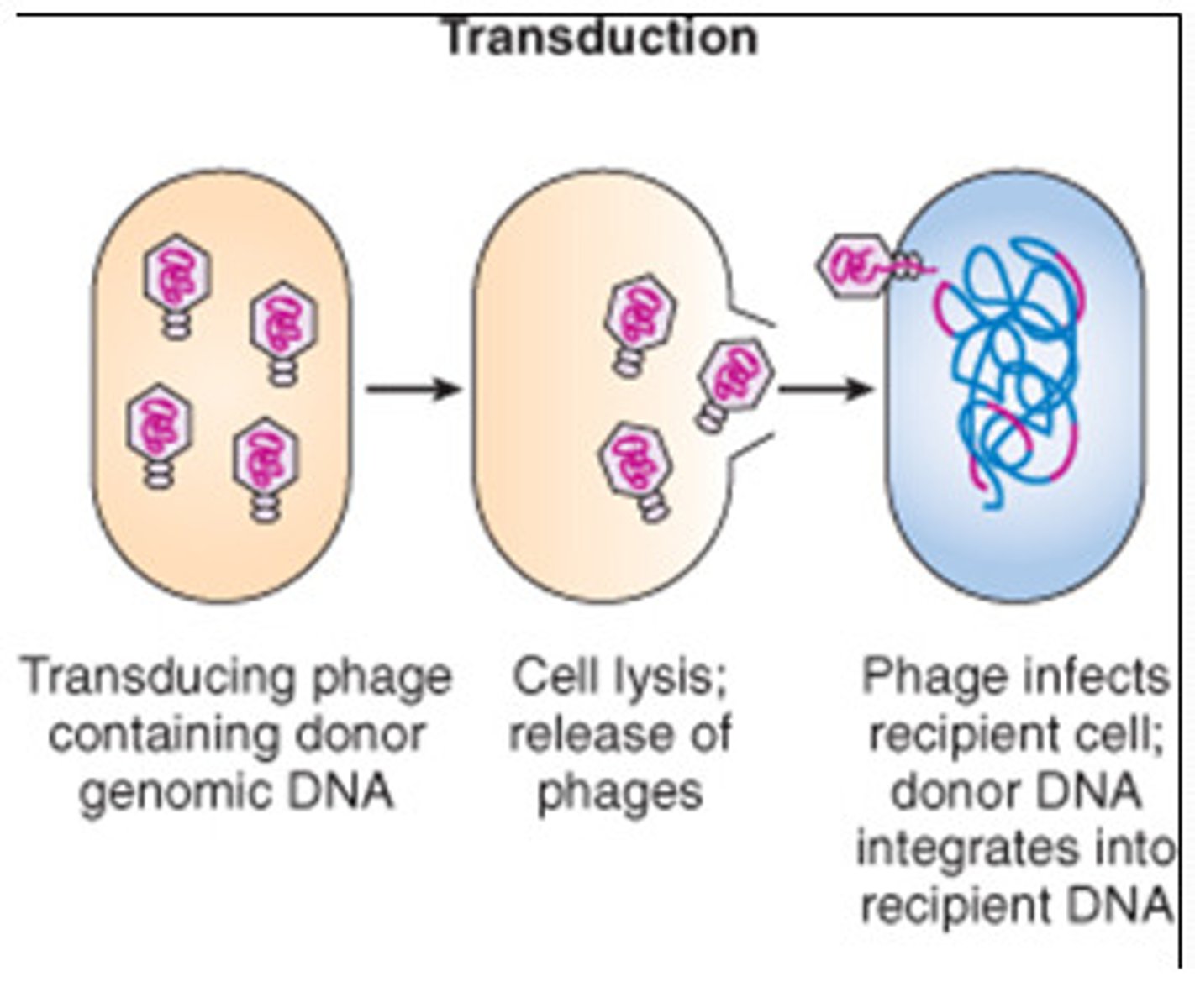
transformation
process in which one strain of bacteria is changed by a gene or genes from another strain of bacteria
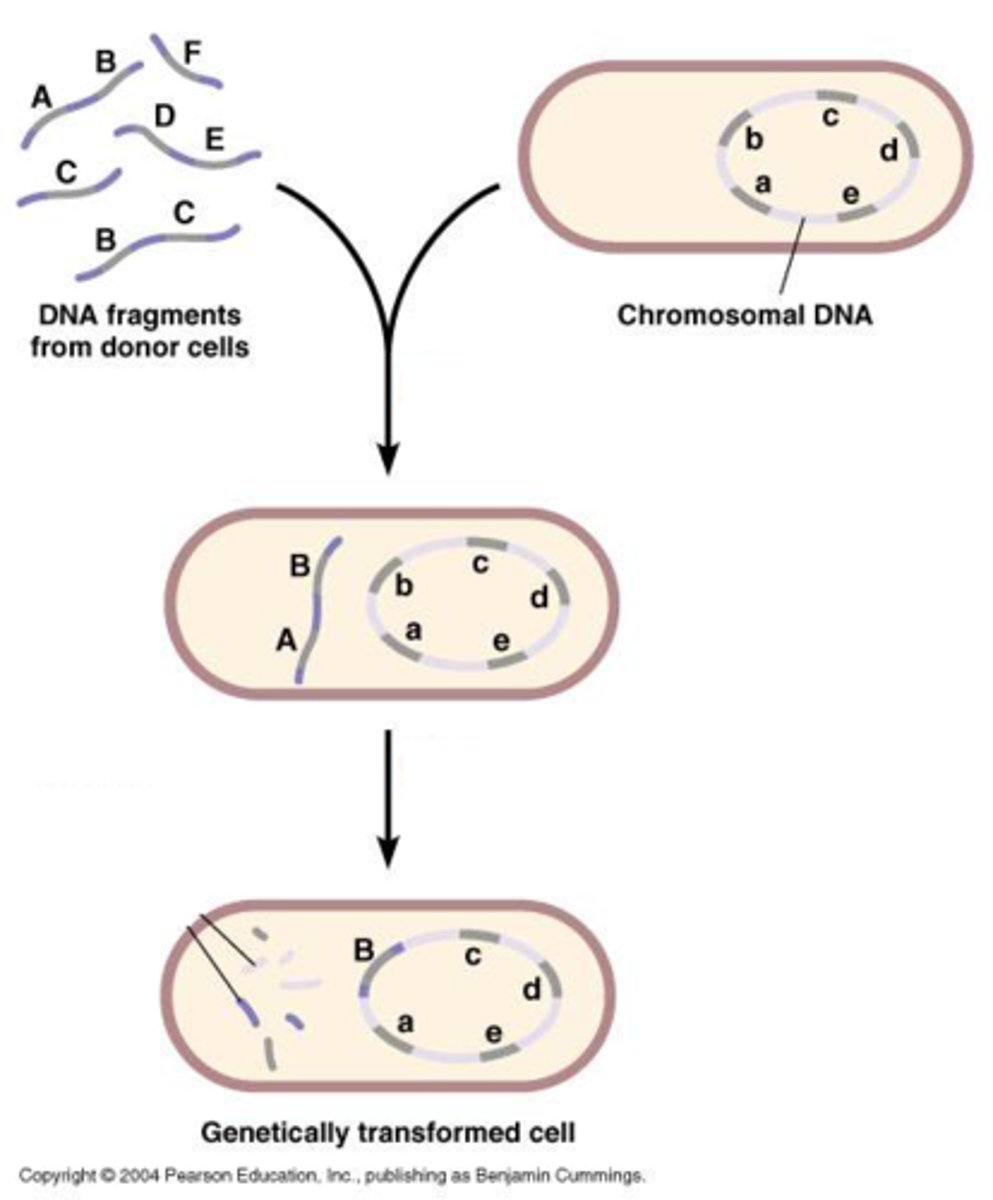
conjugation
In bacteria, the direct transfer of DNA between two cells that are temporarily joined.
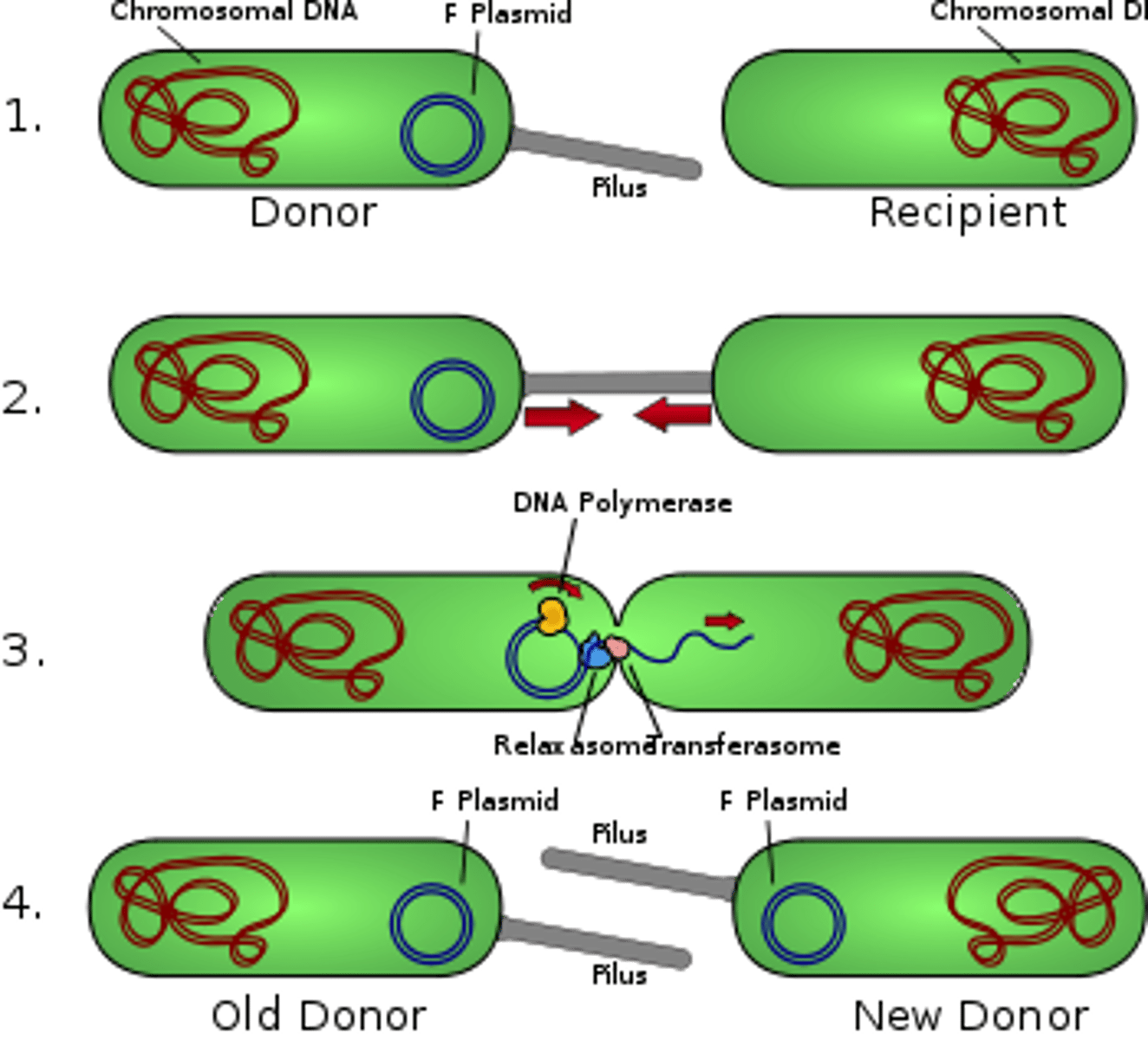
Plasmids
Small rings of DNA found naturally in some bacterial cells in addition to the main bacterial chromosome. Can contain genes for antibiotic resistance, or other "contingency" functions.
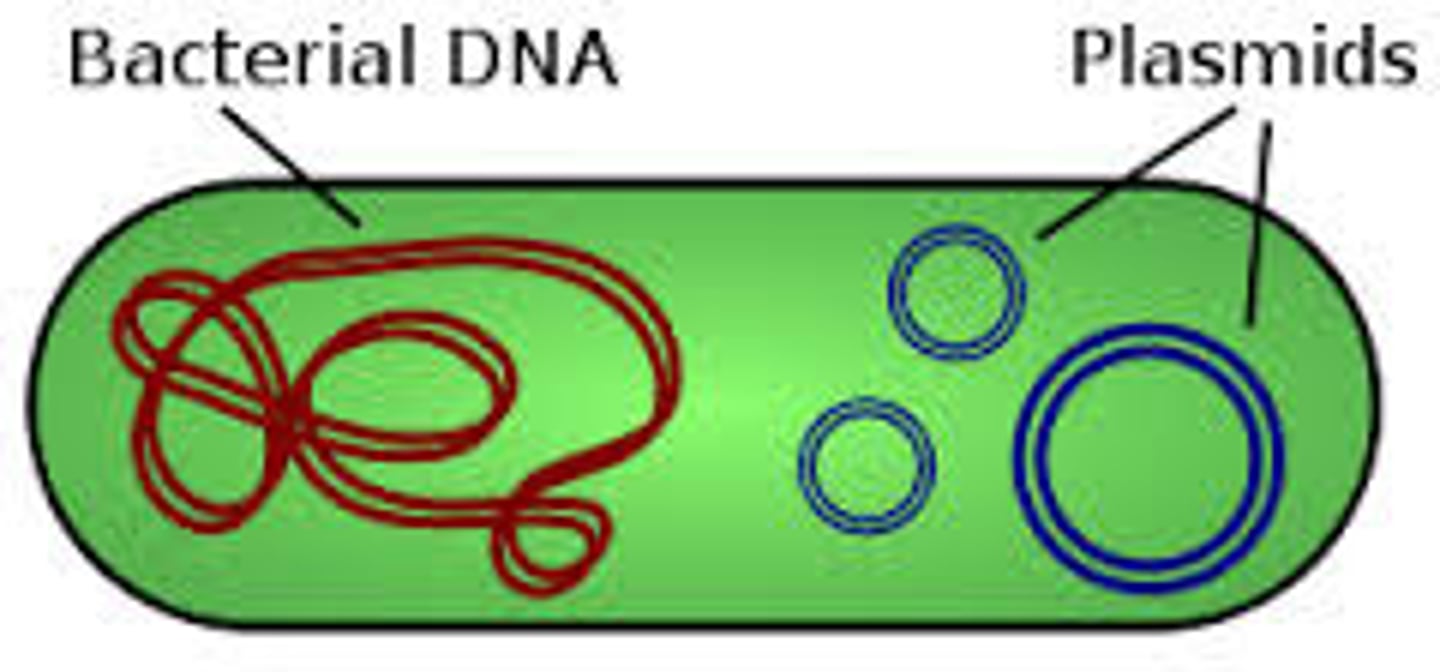
Prokaryotic genome - chromosome
-small size
-extreme diversity
-smaller structure
-HAPLOID
- no sexual reproduction; only conjugation, transformation, and transduction (no male or female, no meiosis)
-no centromere
-mo chromatic
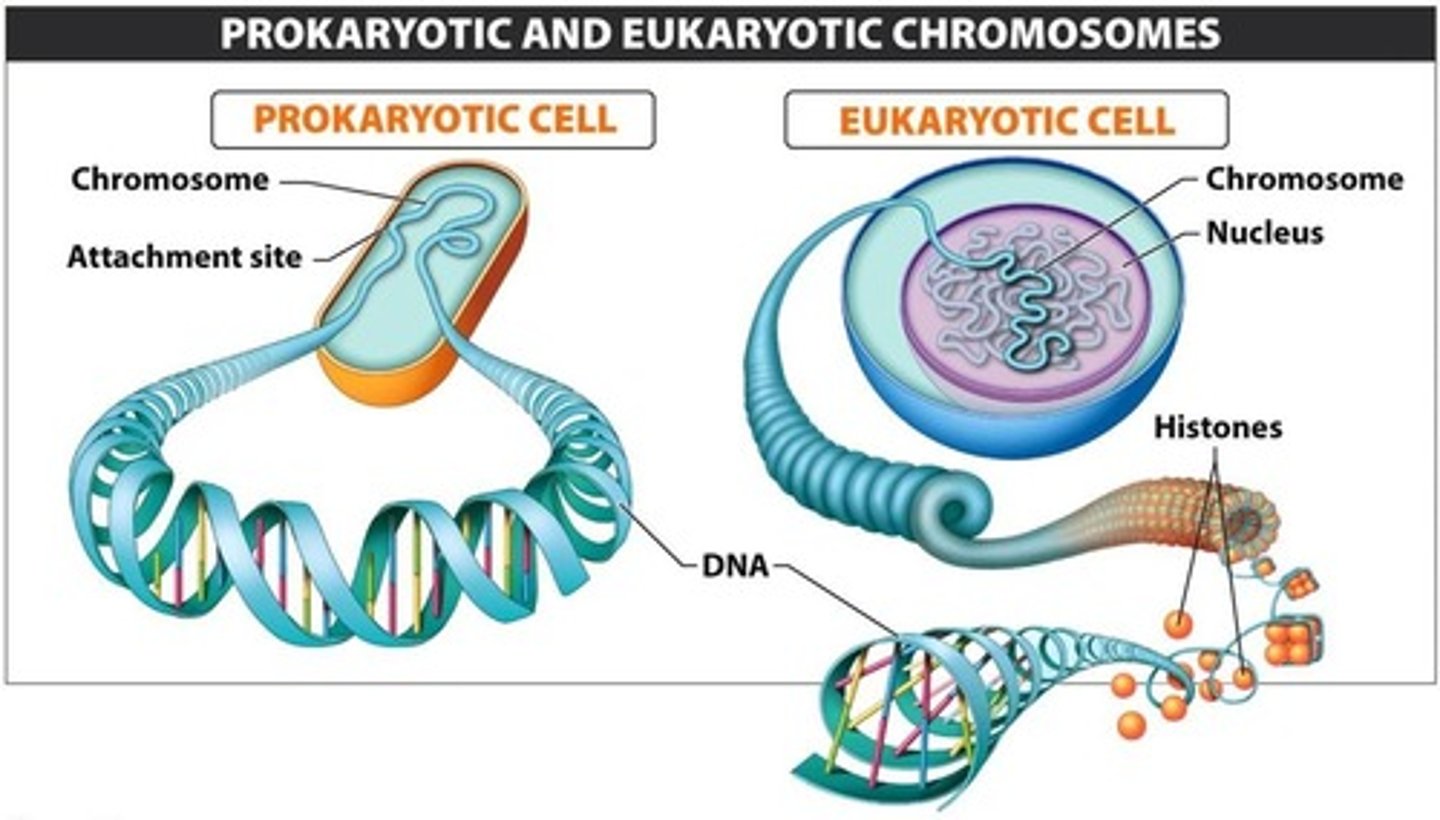
prokaryotic genome - plasmid
-few genes
-independent replication and transcription
-antibiotic resistance genes
-pathogenicity genes
-facilitate LGT
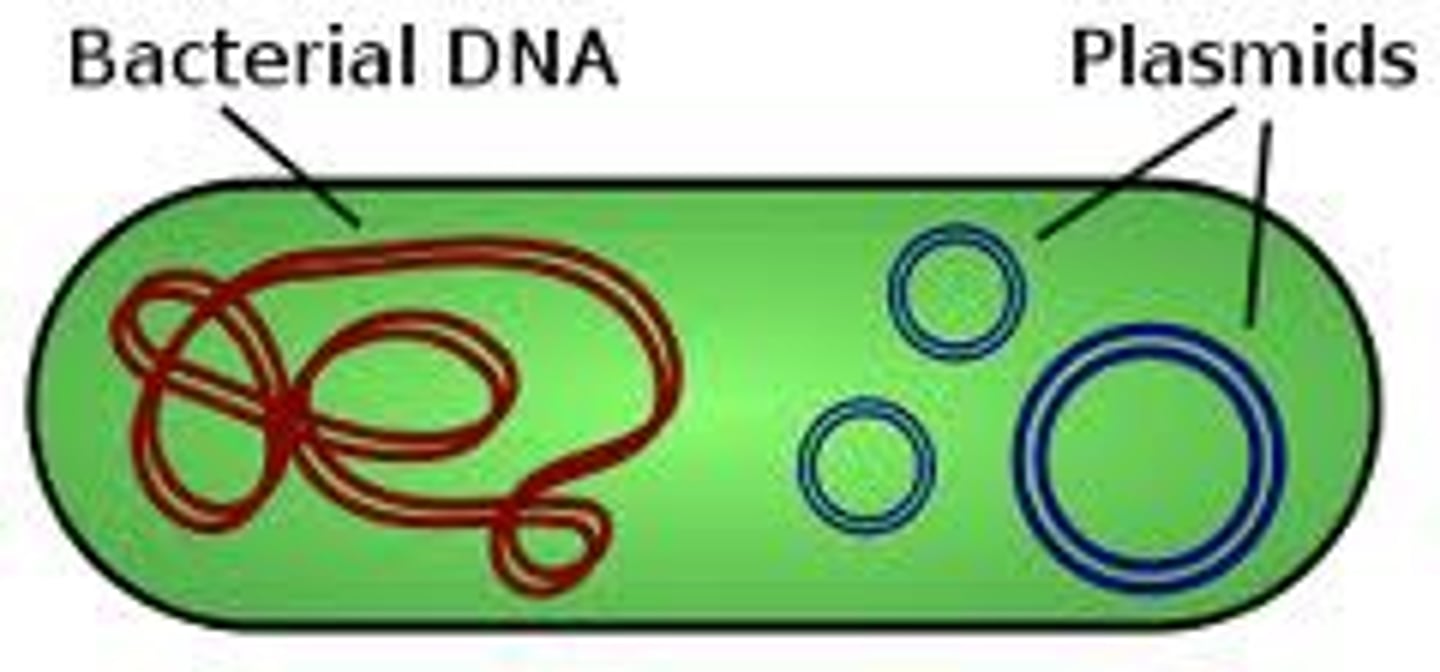
Metabolism
two basic requirements:
-carbon for synthesis of organic compounds
-ENERGY
1. energy (phototrophs use light and chemitrophs use chemical compounds like sulfure and methane)
2. carbon (autotrophs use CO2 and heterotrophs use organic compoints they consume)
autotrophs
make their own food/organic carbon
phototrophs
organisms that get energy from light and carbon from CO2
ex. plants, some prokaryotes, cyanobacteria
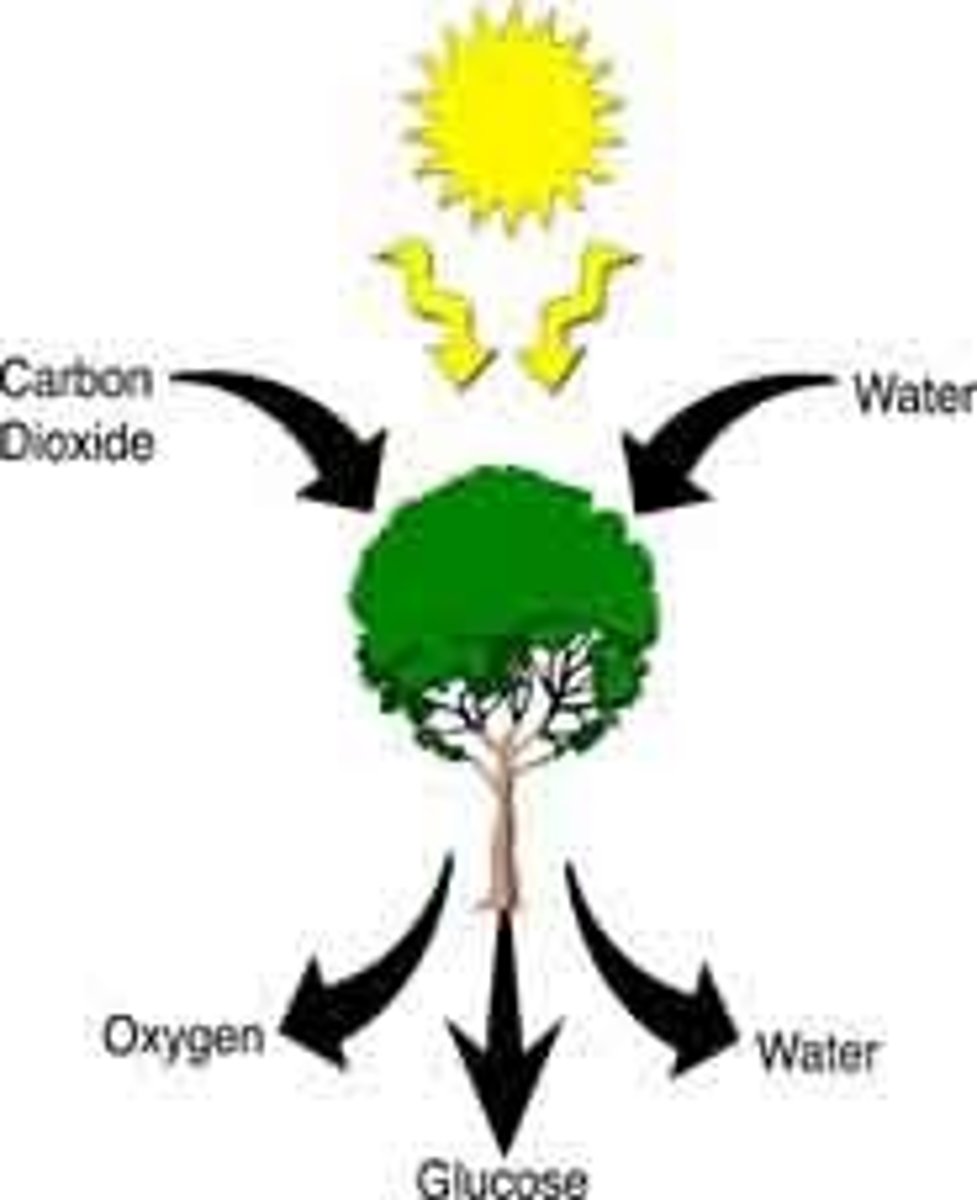
chemoautotrophs
An organism that needs only CO2 as a carbon source but that obtains energy by oxidizing inorganic substances.
ex. some prokaryotes
heterotrophs
consumers of organic carbons
photoheterotrophs
An organism that uses light to generate ATP but that must obtain carbon in organic form.
ex. some prokaryotes like purple nonsulfur bacteria
chemoheteroautotrophs
energy and carbon from organic compounds
ex. some prokaryotes
Glycolysis
A metabolic process that breaks down carbohydrates and sugars through a series of reactions to either pyruvic acid or lactic acid and release energy for the body in the form of ATP
one of the first methods of metabolism that prokaryotes used at the beginning of life
photosynthesis
Conversion of light energy from the sun into chemical energy.
1. uses light as an energy source for making ATP and O2 as a byproduct (usually)
2. use the ATP to create sugars from CO2
Impacts of the oxygen revolution
the origin of cyanobacteria increased O2 levels which is reactive and breaks bonds
bad for the survival of anaerobic bacteria
but allowed for the evolution of aerobic respiration
aerobic respiration
Respiration that requires oxygen
-yielded greater ATP
-in some ways, the aerobic process is opposite to photosynthesis
photosynthesis reaction: ATP from reaction + CO2 -> sugar and O2
aerobic respiration reaction: sugar + O2 -> ATP + CO2
exaptation
a shift in the function of a trait during evolution
evolution is a tinker!
gradual refinement of present structures for new uses
examples
-flowers are modified leaves
-insect wings may have risen as heat collecting devices
how is evolution a tinkerer with photosynthesis and ATP?
1. pathways for production of ATP in aerobic respiration apparently borrowed from (or at least shared with) photosynthesis
bacteria
single-celled organisms that lack a nucleus; prokaryotes

archaea
Domain of unicellular prokaryotes that have cell walls that do not contain peptidoglycan
One of two prokaryotic domains, the other being Bacteria.
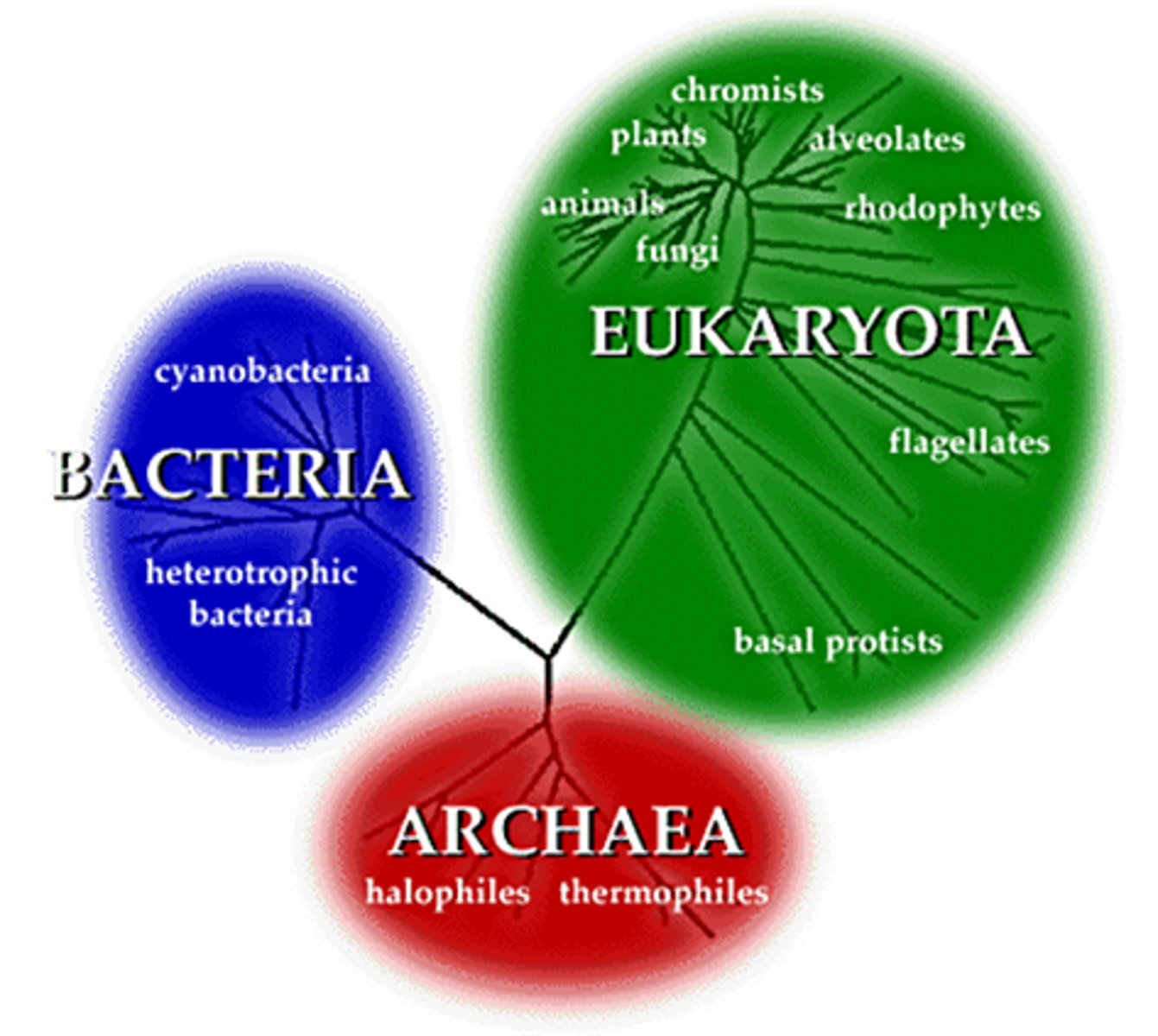
mitosis vs. binary fission
Mitosis: DNA replicates before, complete set of chromosomes are replicated to become sister chromatids
Binary Fission: DNA replicates during, cloning a cell entirely, chromosome replicated is a single, circular DNA strand
order of developed metabolism methods
1. glycolosis
2. photosynthesis
cyanobacteria
Bacteria that can carry out photosynthesis
gram-negative bacteria
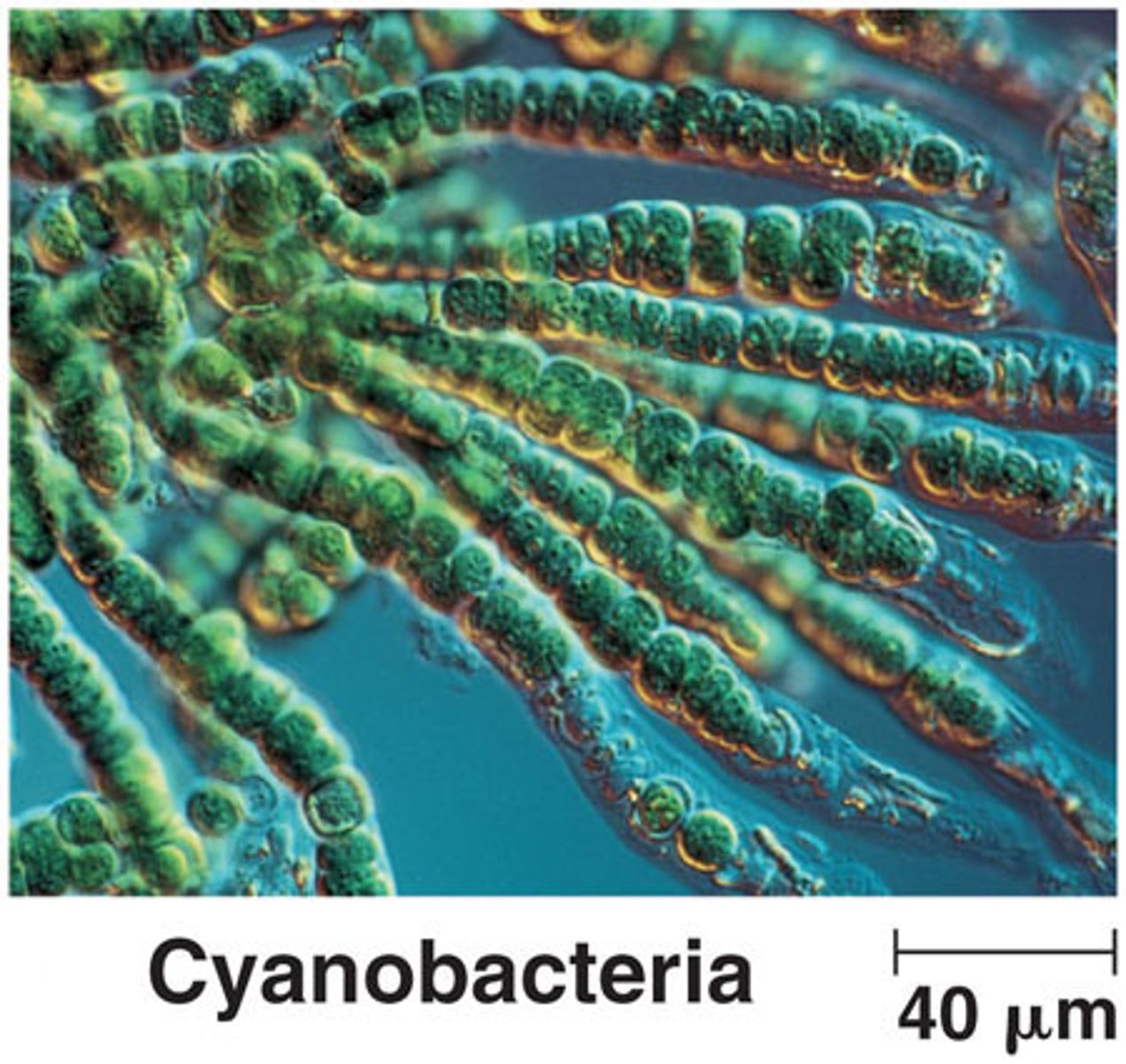
correct bacteria, archaea, and eukarya tree
main reason:
bacteria is made with peptidoglycan layer in the cell wall while the archaea and eukarya do not have peptidoglycan in the cell wall
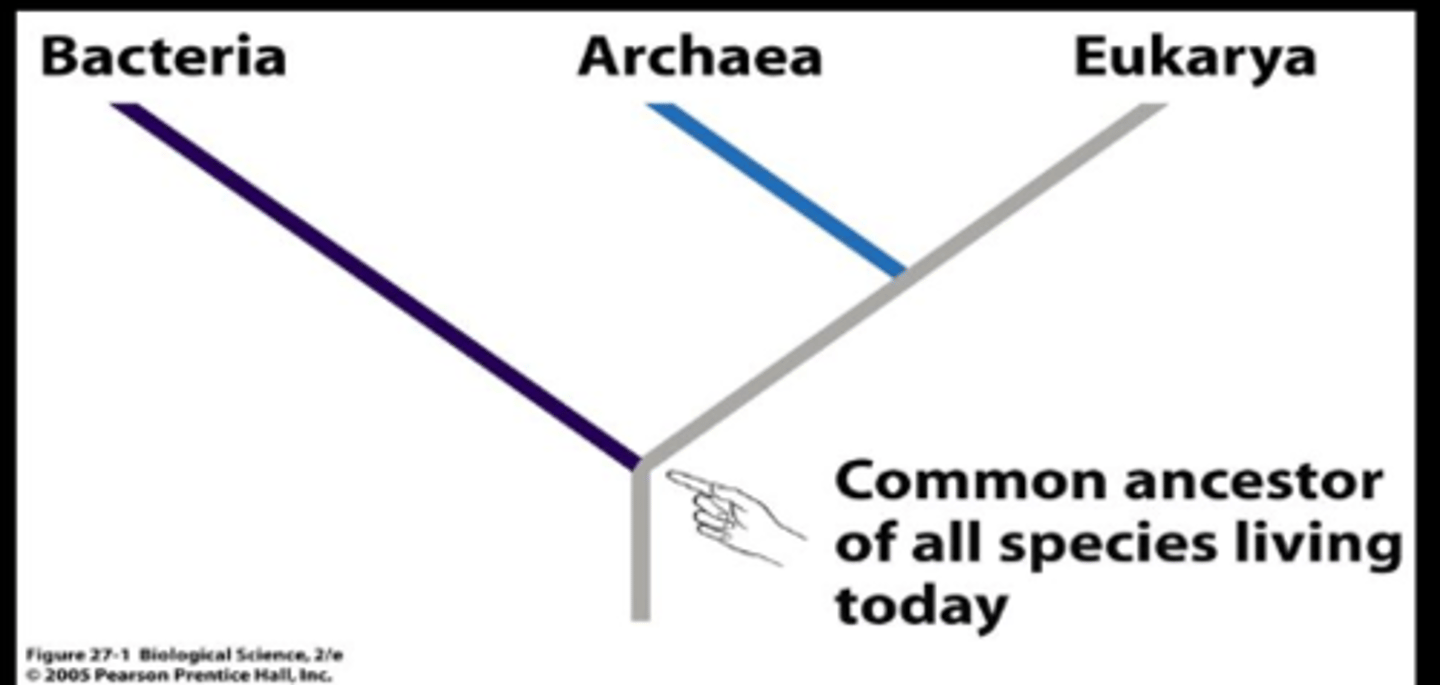
The group 'Prokaryote' is a _________________; and the key distinguishing feature between the two prokaryote domains is the absence or presence of ______________ in their cell walls
A.polyphyletic group; peptidoglycan
B.paraphyletic group; capsule
C.paraphyletic group; peptidoglycan
D.monophyletic group; peptidoglycan
E.monophyletic; capsule
C.paraphyletic group; peptidoglycan
development of the mitochondria
prokaryote with no ability to respire aerobically
consumed a proteobacteria that evolved into the mitochondria

development of the chloroplast
ADD MORE DETAILS TO THE SLIDE
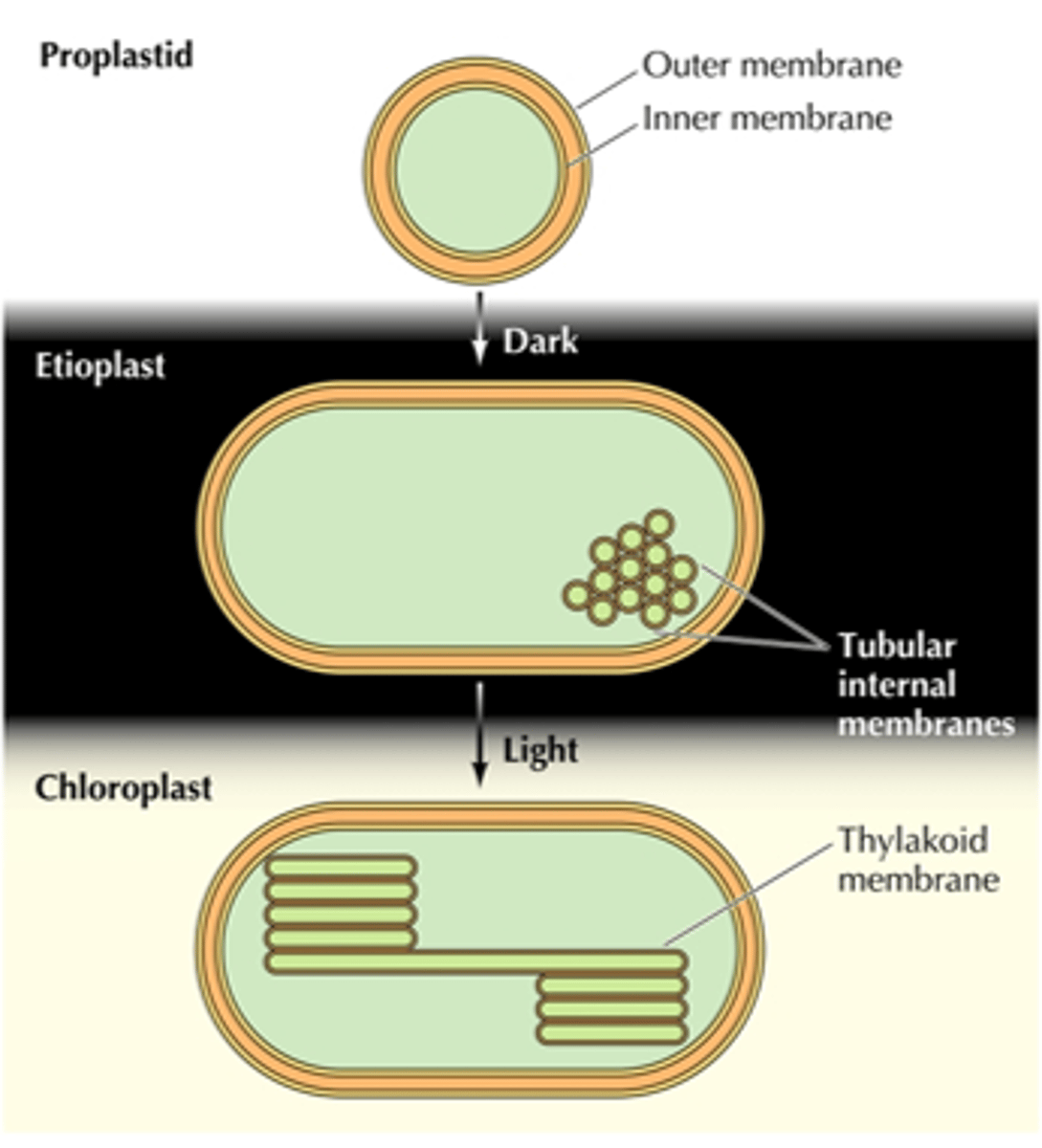
how is evolution a tinkerer?
evolution edits already made mechanisms to become even better (photosynthesis and aerobic respiration)
1) Pathways for production of ATP in aerobic respiration borrowed from photosynthesis
2) Anaerobic origins of photosynthesis apparent even in modern plants
Rubisco enzyme
Splits the 6 carbons into 2 groups of 3 carbon molecules
the most "evolutionary relic" protein that is present in the most species in the world
this protein was relevant when oxygen was not important for existence on earth